Day 1: Arrive in Hanoi, Vietnam.
Arrival Details. Your arrival and departure transfers can be reserved with your guest relations manager, who is assigned to you after you book your tour. You will be met by an Easy Tours Travel Facilitator or your Accompanying Vietnam Tour Director Guide. You are then driven to your top-ranked boutique hotel and assisted with your check-in - available starting 3 PM. The Peridot Grand Hotel is located in the heart of the iconic Old Quarter, and offers a unique blend of artistic design and contemporary comfort. The small hotel’s beautiful décor, exceptional service, and comfortable, well-appointed rooms, combined with its enviable location near major attractions, great restaurants, cafes and bars, as well as the vibrant street scene, make for a great introduction to Hanoi.
The Best Places in Southeast Asia Luxury Small Group Tour
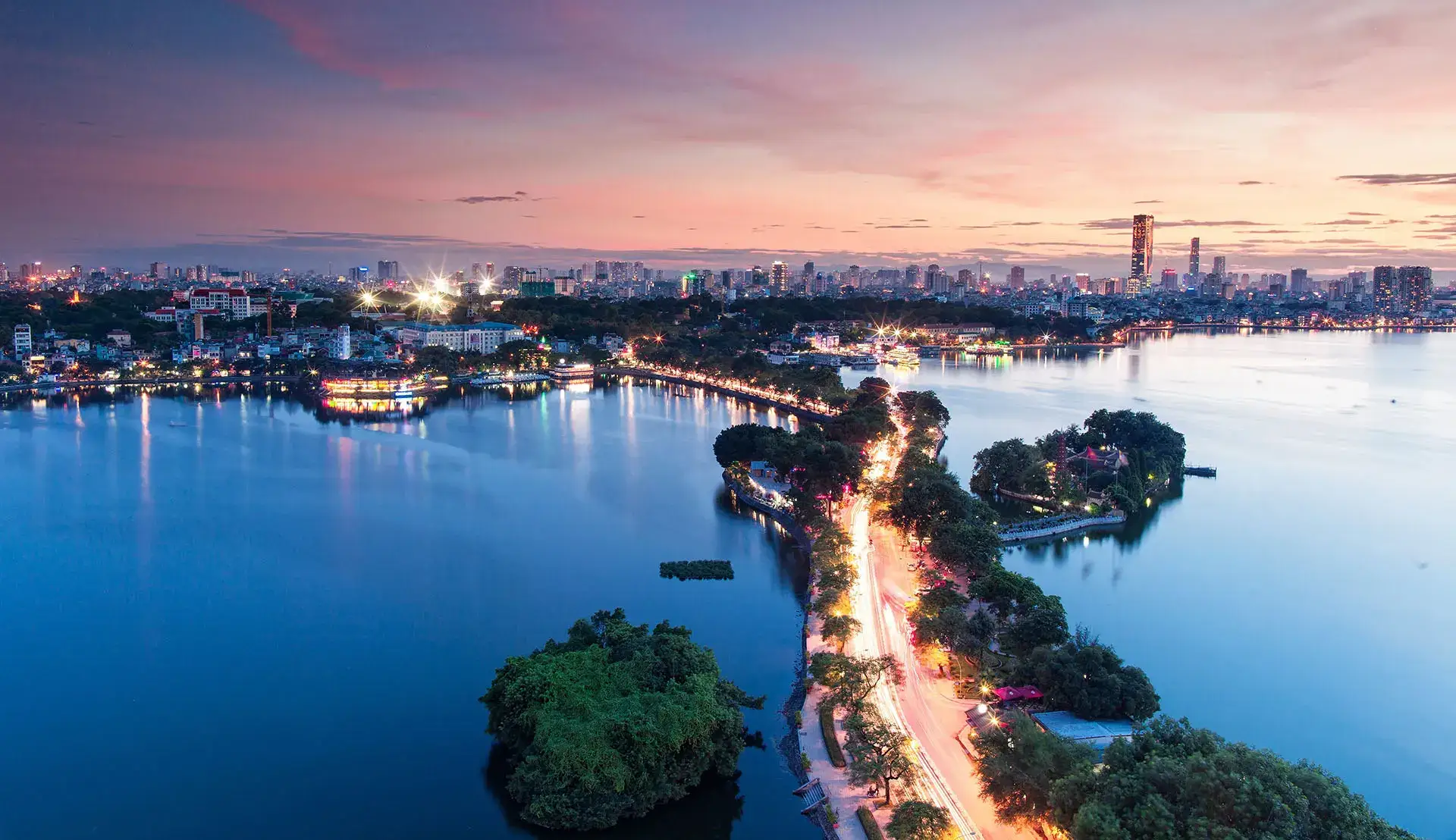
Sunset in Hanoi
Early Arrivals. We strongly recommend that our guests consider arriving a day earlier, as this allows you to recuperate from jetlag, and serves as insurance against international flight delays and cancellations. An additional night’s lodging can be added as part of the process as you reserve your tour. If you are arriving a day earlier, your private airport to hotel transfer will be provided a day earlier.
About Hanoi’s Old Quarter. Hanoi is one of the world’s most fascinating cities to explore on foot, with an exceptionally vibrant street food scene, and its Old Quarter is always abuzz with activity and has an amazing energy that is near impossible to resist. Located on the banks of the Red River, Vietnam's capital retains a unique old-world charm and has some of Asia’s most striking colonial architecture.
(Overnight – Peridot Grand Hotel)
Day 2: Hanoi. (Breakfast, Lunch & Welcome Dinner)
Temple of Literature. Start your exploration of Vietnam’s capital with a visit to the Temple of Literature. Built in 1070 as a Confucian temple and school, this complex became Vietnam’s first university six years later. Multiple courtyards, water tanks, temples, and unique architecture are what you will notice first. A unique sight here is 82 large stone slabs (with large tortoise shaped bases of stone) that have the names and other details of doctoral laureates of the university from 1442 to 1779. It is common to see local students at the temple in school groups throughout the year, and large groups of them are here dressed in their finest during graduation periods. Walk around the complex and its gardens and explore several temples housing beautiful statues of the university’s founders and greatest scholars.
Ho Chi Minh Mausoleum. Next up is the impressive Ho Chi Minh Mausoleum complex. This site is highly revered by the North Vietnamese, and consists of several structures, including Uncle Ho’s (Ho Chi Minh) modest house on stilts, and of course the iconic mausoleum itself. This granite structure stands prominently above the parade area and grandstand at a height of 70 feet and is surrounded by meticulously maintained lawns and gardens. Please note that we do not recommend viewing the preserved body of Ho Chi Minh, housed inside, as this requires a 45 minute (minimum) wait in line, and no photos are allowed.
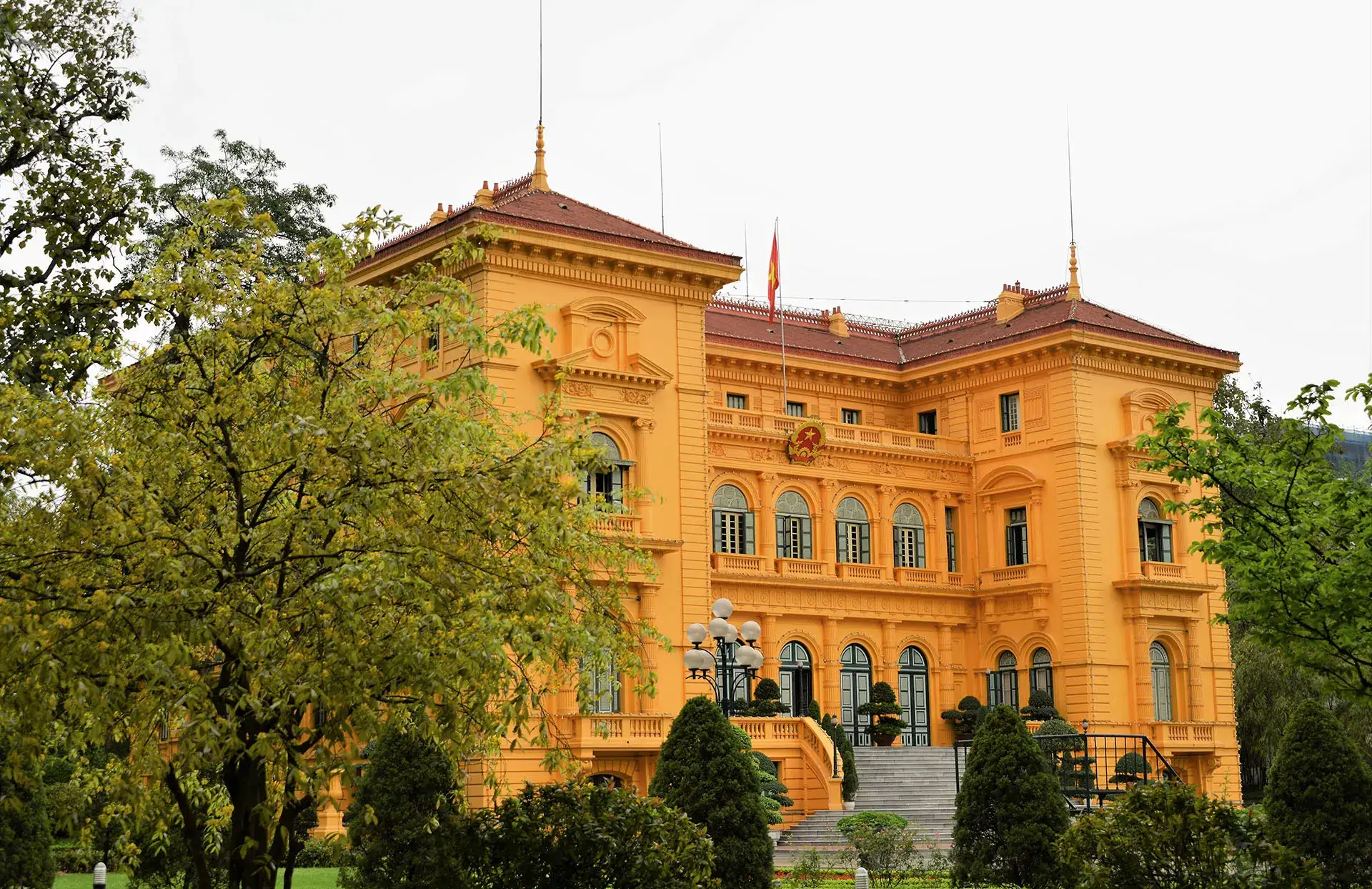
Presidential Palace Hanoi
Presidential Palace. Next to the mausoleum is the beautiful Presidential Palace, built between 1900 and 1906 as the French Governor General of Indochina’s residence. The Palace is not open to the public, but you can stop here for a photo opportunity of the front left profile of the structure, as well as its beautiful gardens. Ho Chi Minh refused to live in the palace and had a simple home on stilts built in the gardens, which you will walk through to admire its simplicity and austerity.
Old Quarter Walk. Return to the old quarter and break for lunch. After lunch you will experience a guided walk through the fascinating historic enclave. When Hanoi was much smaller, this area was the residential, commercial, and manufacturing hub. Each street was dedicated to locals practicing a particular trade, and this practice has continued until today, except the fact that there are far more street food outlets and cafes, adding even more color to an already fascinating sight. Your Tour Director Guide will walk you through streets such as Hand Dong Street (copper wares street) Hang Tre Street (bamboo wares street), and so on. Many of the streets still have temples, pagodas, and communal structures from old times.
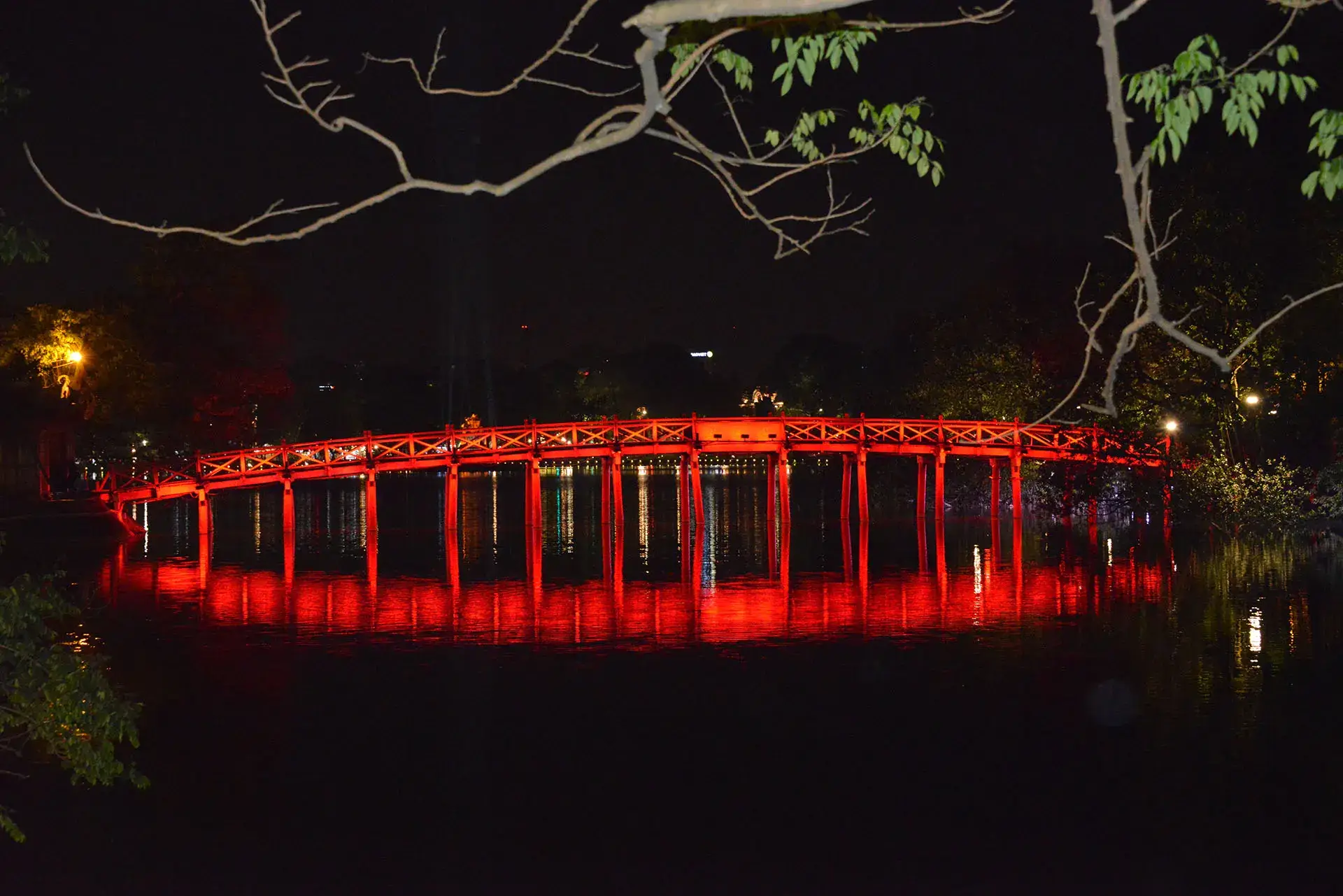
Hoan Kiem Lake Bridge to Ngoc Sun Temple
Welcome Dinner with Vietnam Orientation and Cocktails Event: This evening you will enjoy a short walk through a different part of the fascinating Old Quarter to one of Hanoi’s top-ranked boutique hotels. The elevators will take you to the rooftop bar area from where there is a charming view of Hani and Hoan Kiem Lake. While you enjoy a cocktail, your expert Vietnam Connoisseur Guide will give you an orientation of Vietnam and its culture, and things that you will experience during your exploration. Next you will be escorted to the excellent restaurant on the floor below you (also with a great view) and here you will enjoy a delicious dinner. As with most of your meals while you are in Southeast Asia with us, delicious options between local specialties and western cuisine are available.
(Overnight – Peridot Grand Hotel)
Day 3: Hanoi. (Breakfast and Lunch)
Museum of Ethnology. You'll be driven to West Hanoi to visit the Museum of Ethnology, a remarkable institution dedicated to the diverse ethnic cultures of Vietnam. This unique museum features expansive indoor and outdoor spaces, curated to offer a comprehensive exploration of the country's cultural tapestry. Inside, you'll find an extensive collection of artifacts, including traditional clothing, tools, musical instruments, and household items, each telling the story of the various ethnic groups that call Vietnam home. The outdoor area showcases full-scale replicas of traditional dwellings, including stilt houses and communal halls, providing an immersive experience into the architectural styles and living conditions of these communities.
Citadel of Thang Long (UWHS). Explore the Citadel and the historic colonial administration district. The Citadel of Thang Long, Hanoi's former name, offers a journey through 13 centuries of history. Already a UNESCO World Heritage Site, in 2002 an extensive excavation unveiled relics and cultural layers that you will also enjoy today. Begin at the iconic Flagpole, proceed through the central Kinh Thien Palace, and continue to the Revolutionary House D67, which served as the meeting room for the Politburo and Central Military Commission during the resistance against the US.
Hanoi’s Most Beautiful Avenue. Enjoy lunch at a charming restaurant nestled deep in a narrow alley of this old colonial district. After lunch, take a short walk along Hanoi's most beautiful avenue, Phan Dinh Phung, passing the Cua Bac Church and along the walls and gates of the Thang Long Citadel. The walk concludes at the Dong Xuan Market, the largest in the old quarter.
Electric Buggy Ride. Take an electric buggy ride around the Old Quarter and the iconic Hoan Kiem Lake. Your ride ends at your hotel, where you can take a break.
Lake of The Restored Sword. In the afternoon, you'll visit Hoan Kiem Lake, also known as The Lake of the Restored Sword, and the Ngoc Son Temple, perched on a small island within this picturesque lake. As you cross the iconic red wooden bridge to the temple, you'll observe the fascinating rituals performed by the devout locals. They visit throughout the day to pay respects, offer incense, and make prayers. You might see people lighting candles, burning joss sticks, and presenting offerings of fruit and flowers. The air is filled with the scent of incense and the soft murmur of prayers, creating a serene and spiritual atmosphere. The temple itself, dedicated to General Tran Hung Dao, a national hero, is adorned with intricate carvings and statues, reflecting Vietnam's rich cultural heritage.
Water Puppetry. In the early evening comes a fascinating performance of Water Puppetry, where Easy Tours guests will enjoy preferred seating. The Thang Long Puppet Theatre is Hanoi’s most famous because of the quality of the performers, and it is located on the banks of Hoan Kiem Lake, across from Ngoc Son Temple. This art form, which is unique to North Vietnam, originated in the 11th century. The combination of indigenous music, small fireworks, and the colorful wooden performers, as well as the accomplished musicians visible in the gallery, makes this spectacle a great introduction to North Vietnamese culture.
Old Quarter Night Walk. After the performance, you will enjoy a short walk to your hotel by the charming lake, walking past the locals as they dine on street food, an activity that is omnipresent at night all over the Old Quarter. By now you will start realizing that the Vietnamese take street food to a whole new level, even by Southeast Asia standards – people eating are everywhere, occupying sections of the pedestrian walkways, parks, sometimes taking over parts of the roads after sunset, enjoying the wares of scores of small street stalls.
(Overnight – Peridot Grand Hotel)
Day 4: Hanoi – HaLong Bay. (Breakfast, Lunch and Dinner)
Drive to Ha Long - Start Cruise. Check-out from your hotel in the morning, and then you are driven to an island off the coast of Ha Long. Upon your arrival you will join your fellow cruise travelers in a reception area where refreshments will be served. After a while you will be assisted in boarding your top-ranked luxury vessel. This is one of the newer cruisers on the bay and you will be in a beautiful balcony cabin on the upper deck with wonderful views.
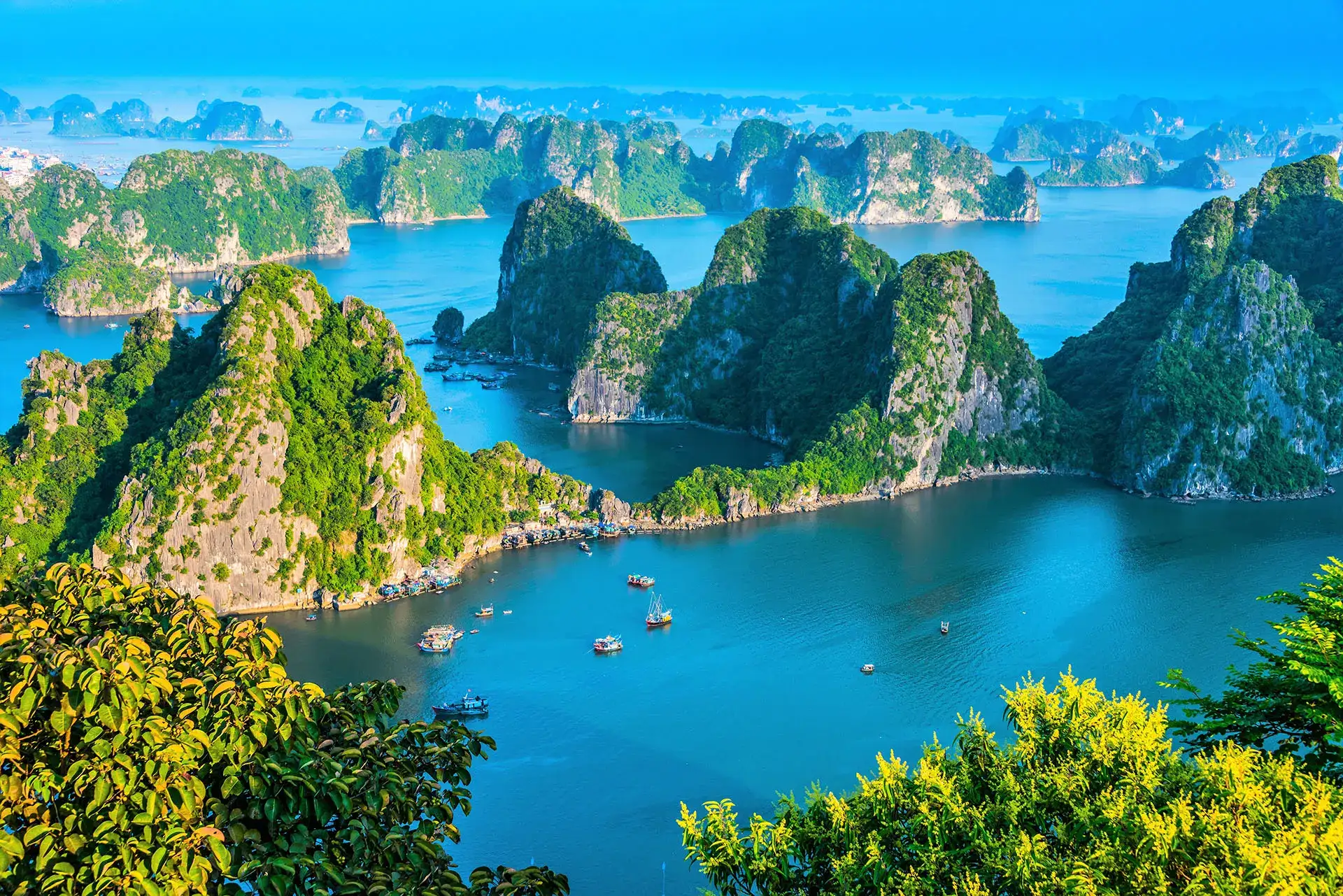
Halong Bay Arial View
HaLong Bay. The entire bay on this coast of Vietnam is one of the world’s most spectacular seascapes, resulting in it being listed on the UNESCO World Heritage List. The water is very calm on the bay, and the scenic beauty is characterized by a vast area that is full of lush limestone (karst) hills jutting out of the ocean. Your cruise will cover parts of Ha Long Bay and Lan Ha Bay and you will visit some of the main attractions, but you will also spend quite a bit of time where most other cruises don’t go, in stunning locations that are a little off the beaten track.
Excursions and Activities. You will have various excursions available during your cruise, including options to kayak, swim, visit floating villages, and a lot more, and there will also be a full schedule of activities on the ship that you can participate in. Excellent Vietnamese and western cuisine options will be served throughout your cruise. Lunch is served shortly after the cruise begins.
(Overnight - Paradise Grand Cruise)
Day 5: Ha Long Bay – Hue. (Breakfast and Lunch)
Cruise, Excursion, & Disembark Wake up a little early to stunning views and then enjoy breakfast, after which you have the option to experience this morning’s scheduled excursion. Return after the scheduled morning excursion, and a full brunch will be waiting for you. The boat now begins its leisurely cruise to the dock, giving you plenty of time for more relaxation and photography. Check out of your cabin and you are met by your Guide and chauffeur at the dock.
Flight to Hue. You are then driven to Hanoi airport to board your flight to Hue, The City of Mist. From Hue Airport you are driven to your art deco historic riverfront resort for check-in. By far Hue’s best lodging option, it was the residence of the French Resident Superieure (Governor) in times past. Time Magazine listed this hotel in its best hotels in the world in 2019, and the resort has received countless other awards. We use the larger Deluxe Rooms as the standard Superior Rooms are a little small.
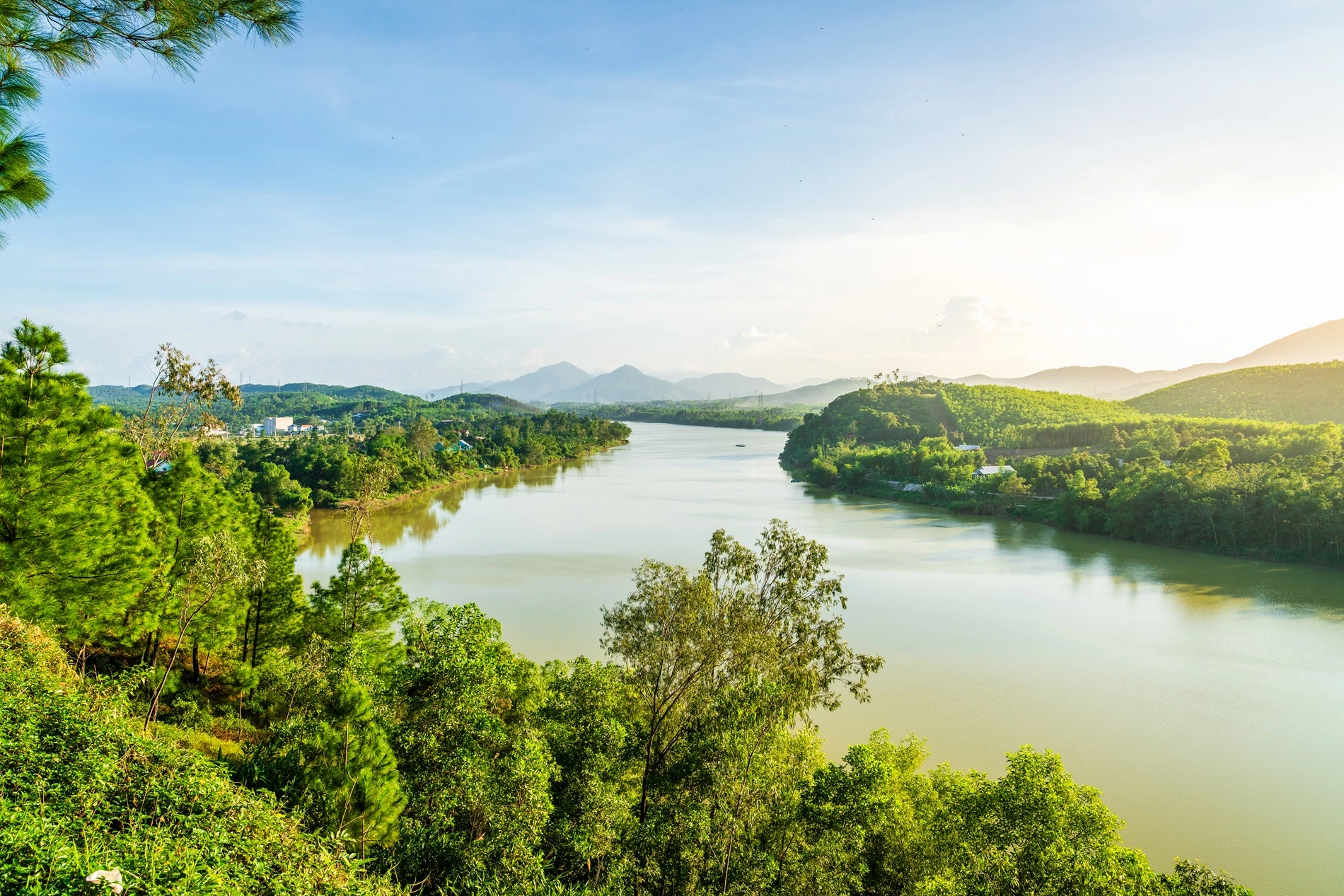
Perfume River
The City of Mist. Hue is known for its magnificent monuments built under the Nguyen Dynasty (1802 - 1945), and also famous for its amazing food, as well as its unique conical hats. Unlike Hanoi and Saigon, the city has a relaxed vibe, and evening walks by the Perfume River, and the delightful cafes that are found here, are highly recommended. The monuments that you will visit here make up one of Vietnam’s eight UNESCO World Heritage Sites. This honor was bestowed on the city in 1993 since it is such a fine example of an eastern feudal capital.
(Overnight – Azerai La Residence)
Day 6: Hue. (Breakfast and Lunch)
Royal Mausoleums. Your day will start in the morning with a visit to the impressive mausoleum of King Tu Duc (ruled 1848 - 1883). Close by is the next attraction, the unique mausoleum of King Khai Dinh (ruled 1916 - 1925). These ornate and colorful monuments, designed by the kings themselves, were also used as holiday retreats during their lifetimes.
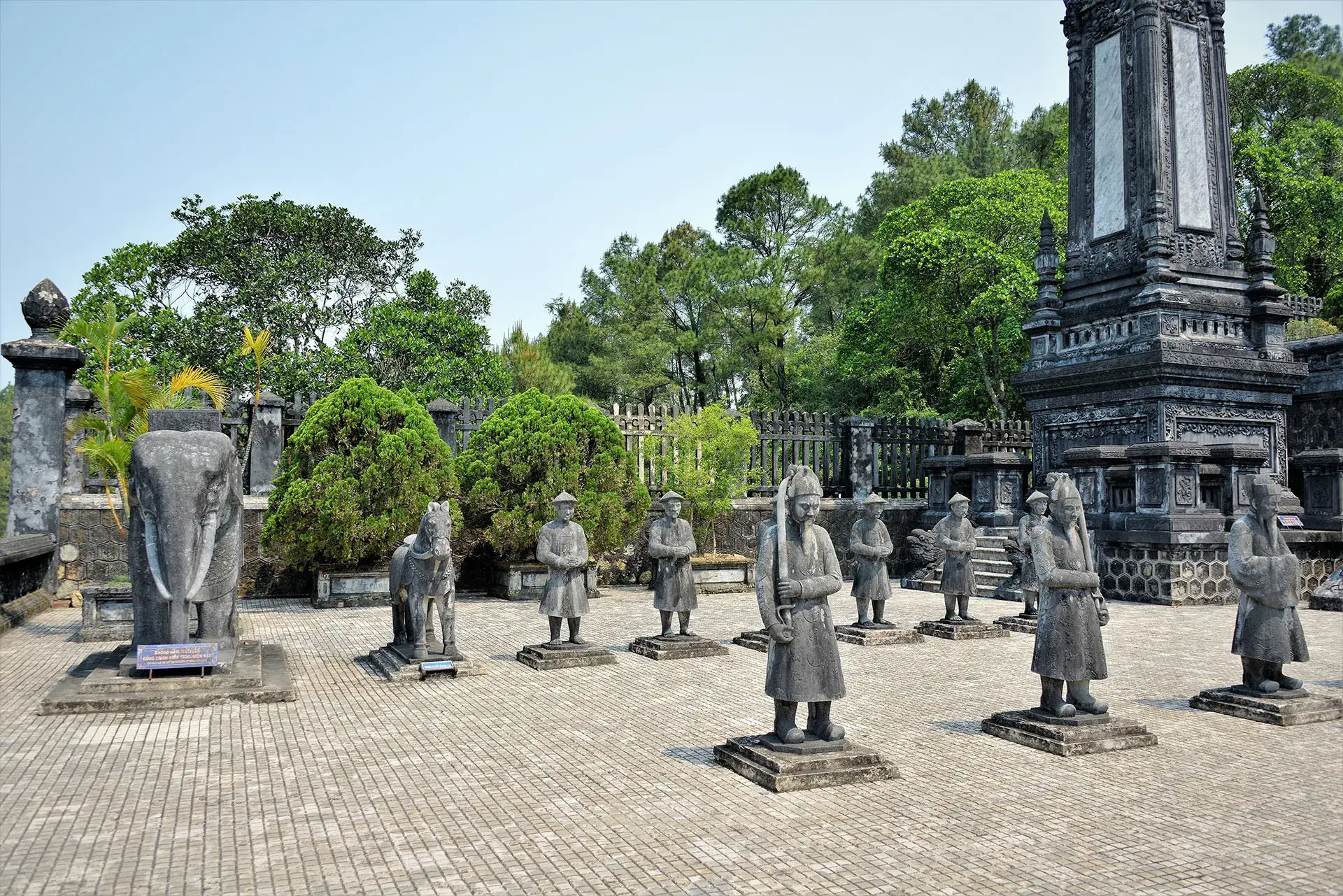
A Courtyard at King Tu Duc's Mausoleum
Old Town Walk. Next you will enjoy a guided walk-through older part of Hue, including a busy market located next to the river. The market is teeming with local vendors selling a variety of goods, from fresh produce to handmade crafts. The air is filled with the aroma of exotic spices and the sounds of lively bargaining. People are bustling about, some buying, some selling, and some just enjoying the lively atmosphere. There are also local artisans displaying their crafts, including the traditional Hue hats. The river provides a serene backdrop to this lively scene, with small boats gliding gently along the water.
Imperial City. After a lunch break you will continue your exploration with a visit to the Royal Citadel. The sprawling complex of palaces, fortifications and pagodas was, in its day, virtually impenetrable. The tour of this Imperial City features monuments such as the Flag Tower, Noon Gate, Nine Dynastic Urns, Nine Holy Cannons, Thai Hoa Palace (Palace of Supreme Harmony), and the Forbidden Purple City.
(Overnight – Azerai La Residence)
Day 7: Hue – Hoi An. (Breakfast and Lunch)
Scenic Drive to Hoi An. Embark on a scenic 3.5-hour (approximately) drive to Hoi An. Some of this drive is through coastal fishing villages, and much of it is on one of Southeast Asia’s most spectacular roads, where you straddle the Pacific Ocean with amazing views on one side, and lush green hills on the other. At the highest point of the journey, you will have a breathtaking view of the Pacific, and on the other side a view of the modern city of Da Nang and its bay. You will drive through the outskirts of Da Nang as you head towards Hoi An, and a brief photo opportunity stop will be at the beach zone that was a favorite for American soldiers during the Vietnam war, immortalized in the television series China Beach.
Inland to Hoi An. Arrive near historic and charming Hoi An in the early afternoon, in time for a slightly late lunch at a very nice beachfront restaurant. After lunch, you will be driven inland for about 15 minutes and assisted with your check-in at your top-ranked boutique resort. Although the Heritage town of Hoi An is an ancient seaport, it is now about 3 miles from the coastline as the crow flies. Easy Tours uses the highest rated and top-ranked lodging in Hoi An, and the boutique lodge is located within Hoi An and is a very short walk or drive from the UNESCO Site.
Location and Comfort. You will be staying in a beautiful Verandah Suite in the more exclusive and relatively new Club Section of the lodge, and the services and cuisine are among the best you will experience anywhere in Southeast Asia. A leisurely 10-to-15-minute walk, 3-minute taxi ride, or a 5-minute bike ride (complimentary at your resort) can bring you to the ancient town in case you want to return there at any time during your stay. Although the food at your lodge is excellent, we also recommend the extremely charming French inspired riverfront restaurants and cafes in the ancient town for dinner this evening.
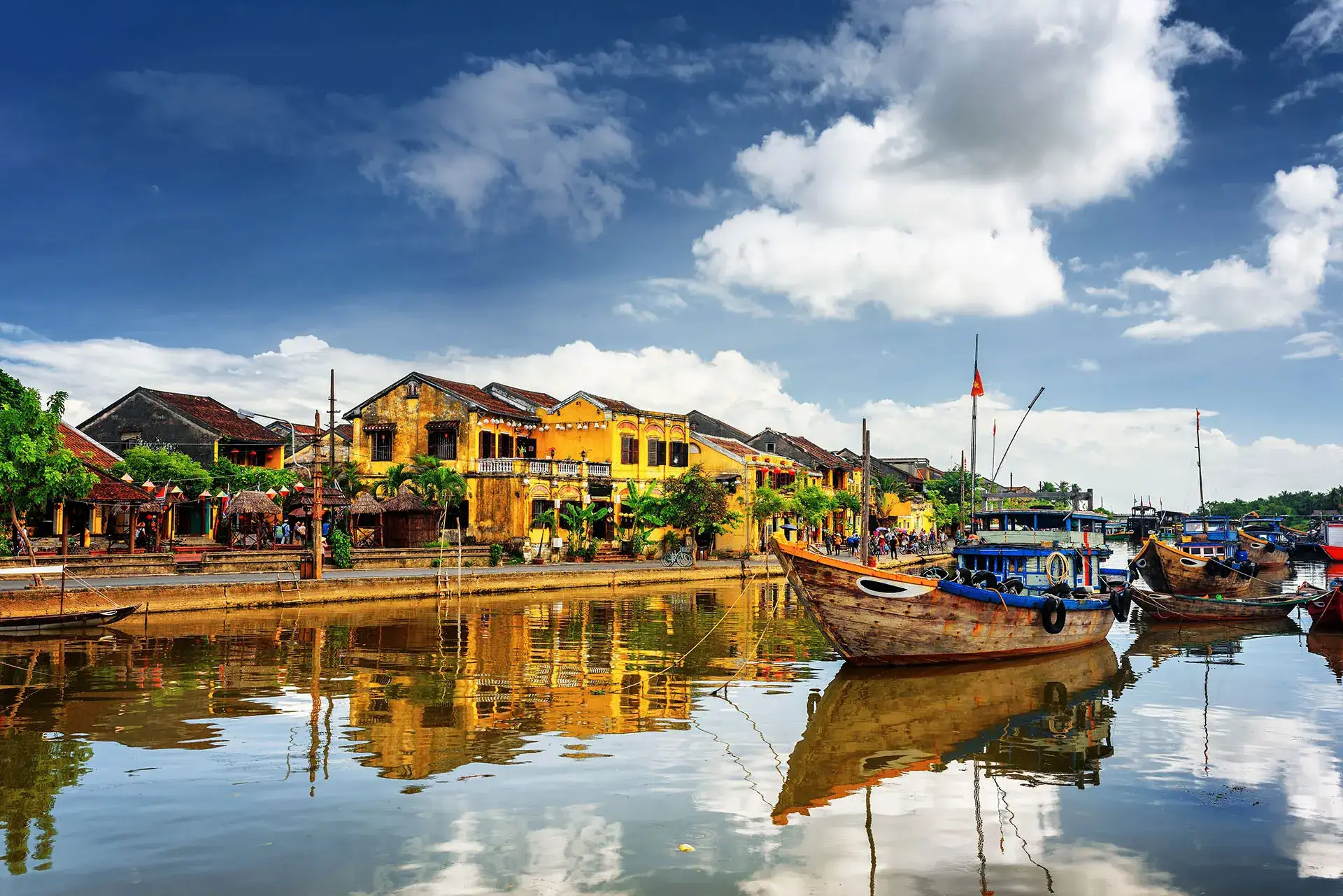
Hoi An
Hoi An (UWHS). Hoi An is classified as a UNESCO World Heritage Site as the best-preserved ancient seaport in Southeast Asia. Easy Tours prefers not to take our guests to the ancient town during the late morning and early afternoon as, during those hours, it gets really crowded and noisy due to a large influx of tourist bus groups from the large Da Nang casino resorts. We begin your discovery of the ancient seaport in the late afternoon with a guided walk through the Japanese and Chinese Quarters of the tiny ancient town. One of the highlights is the beautifully crafted and much-photographed Japanese Bridge. You will also visit a number of temples, pagodas, communal houses, traditional shops, and other places of interest in the small town.
Evening in Hoi An. You can either head back to your resort in the early evening, or, those who want to continue experiencing the ancient town this evening can then have dinner at one of the delightful cafes and restaurants located on the river – the better restaurants have a distinctly French ambiance.
(Overnight – La Siesta Resort & Spa)
Day 8: Hoi An. (Breakfast and Lunch)
My Son Sanctuary Excursion. Join your Tour Director Guide for an excursion to the UNESCO World Heritage Site of My Son Sanctuary. These remarkable structures lie about an hour away from Hoi An, and the structures go back as far as the 4th Century. It is one of the most important examples of Hindu influence in Southeast Asia. Although largely in a state of ruin today, My Son is often compared with other historical temple complexes in Southeast Asia, such as Angkor Wat of Cambodia or Ayutthaya of Thailand. You'll be given a brief introduction to Cham history and culture, and its Hindu influence, and then you will visit the remains of the carefully crafted red brick temples replete with beautiful monuments and epitaphs.
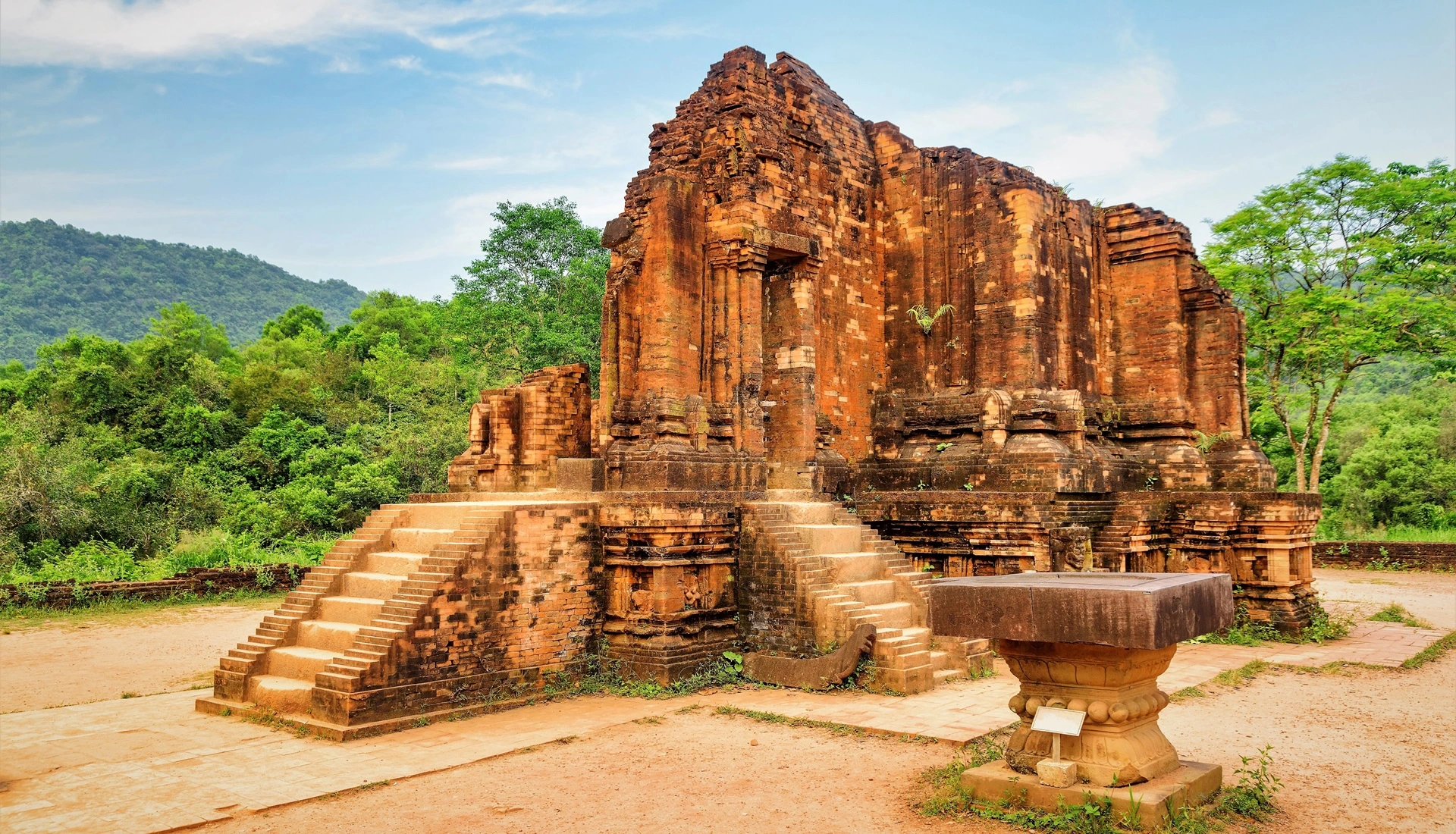
My Son
After an introduction of Cham history and culture (and its Hindu influence) during your drive, you will arrive at the ancient site. My Son served as the capital of the Champa Kingdom and the site contains over 70 temples and structures built from the 4th to the 14th century. These temples were constructed using fired brick and stone, showcasing sophisticated Cham engineering and artistry. The temples are adorned with intricate sandstone bas-reliefs depicting scenes from Hindu mythology and Cham history. The temples are noted for their unique construction technique, which involves using a plant-based resin as mortar, making the structures remarkably durable and weather-resistant.
Return to Hoi An and break for a late lunch in the wonderful ancient town of Hoi An. After lunch you are driven to your nearby resort for leisure until the evening entertainment. Guests who want to explore more of the ancient town can choose to return on their own during the afternoon.
Hoi An Memories Show. A little after 7 PM you are escorted to the ancient city for a wonderful outdoor cultural performance, held on an island on the Thu Bon River. You have upgraded seating at the show which covers 400 years of Hoi An's history through five distinct acts performed by over 500 actors. It takes place on a 270,000 square foot stage designed to resemble the ancient town of Hoi An, complete with elaborate sets, merchant ships, and even a rolling elephant. Visitors are taken on a journey through time, witnessing Hoi An's transformation from a rural village to a vibrant trading port. The narrative is driven by the visual and emotional impact of the performances rather than dialogue, making it accessible to all audiences.
Day 9: Hoi An – Da Nang – Saigon. (Breakfast, and Lunch on Flight)
Fly to Saigon. Check-out of your resort in the morning and you are driven to Da Nang airport, crossing the charming Dragon Bridge on the way. You are assisted in boarding the noon flight to Saigon. Upon arrival at Saigon Airport, you are driven to Cu Chi, located in the countryside north of Saigon.
Cu Chi Tunnels. This area is famed for its elaborate network of over 200 kilometers of three-story underground tunnels hand-dug by local people during the Vietnam War. You have the option to experience climbing down into a tunnel and crawling around to get a taste of how the North Vietnamese soldiers (Viet Cong) lived during the latter part of the war. There are displays of weaponry that was used, as well as life-sized mud likenesses of the North Vietnamese soldiers depicting the lives they lived.
District 1. After this experience you are driven to Saigon where you are assisted with check-in at your hotel in the heart of Saigon’s downtown (District 1). The Lotte Saigon is a highly rated contemporary luxury hotel, and your rooms have a great view of the Saigon River. Restaurants, bars, and shopping are right at your doorstep, as are historical structures such as the Opera House.
Saigon. You are a couple of minutes’ away from the scenic Saigon River. For those interested, dinner and/or a drink is recommended at the Saigon Saigon Rooftop Bar at the nearby upscale Caravelle Hotel – this is the spot where American correspondents such as Dan Rather, Tom Brokaw and Peter Jennings received their daily war briefing and it was their favorite watering hole during that time. Both the food and the drinks are very good.
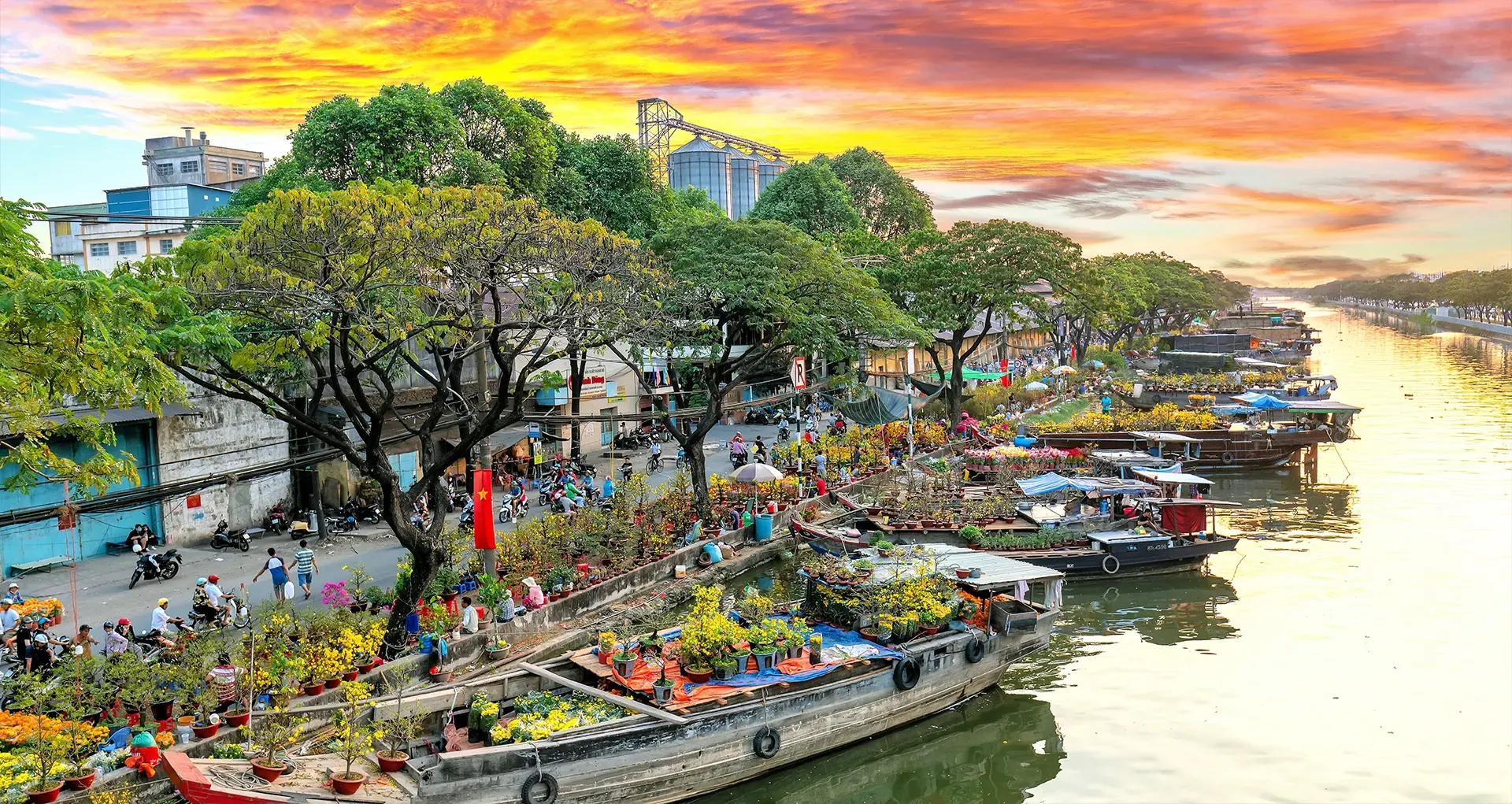
Nursery on Canal
Ho Chi Minh City. Located near the mouth of the Mekong, this city was once nothing more than swampland inhabited by a few Khmer people. Today it is Vietnam’s largest and most metropolitan city, with its official name, but most everyone still calls it Saigon. The city of over 9 million people is a prototypical large Asian city with an impressive modern skyline overlooking busy streets overflowing with, for western visitors, chaotic scooter, motorcycle and other traffic.
(Overnight – Lotte Hotel Saigon)
Day 10: Saigon. (Breakfast and Lunch)
Reunification Palace. You will start your day in the morning with a visit to the Reunification Palace. This was the headquarters of the United States supported South Vietnamese government and has been left largely as it appeared on the day the Viet Cong’s tanks crashed through the gate and claimed victory for the North. The original furniture, equipment rooms, and war rooms remain untouched, all the way down to the rotary phones on the desks and strategic maps on the walls.
Travel Back Half a Century. In the middle of the crowded city, this large structure and its vast grounds are a fascinating time warp taking you back to the early 1970’s. Next, enjoy a visit to the beautiful colonial building housing the Central Post Office, with its amazing collection of century old western telegraphs and other machines. This is an active place of business, and the gorgeous antique interior includes wooden phone booths and counters that the locals will be standing at while buying services.
Central Post Office. After lunch you will enjoy a walk-through Saigon, including the famous shopping street of Dong Khoi. Your guided walk will begin at the Saigon Central Post Office, a stunning example of colonial architecture with its ornate facade and grand interior. This post office is not just a place for mail services; it's a historical landmark, showcasing French colonial influences and featuring a large portrait of Ho Chi Minh.
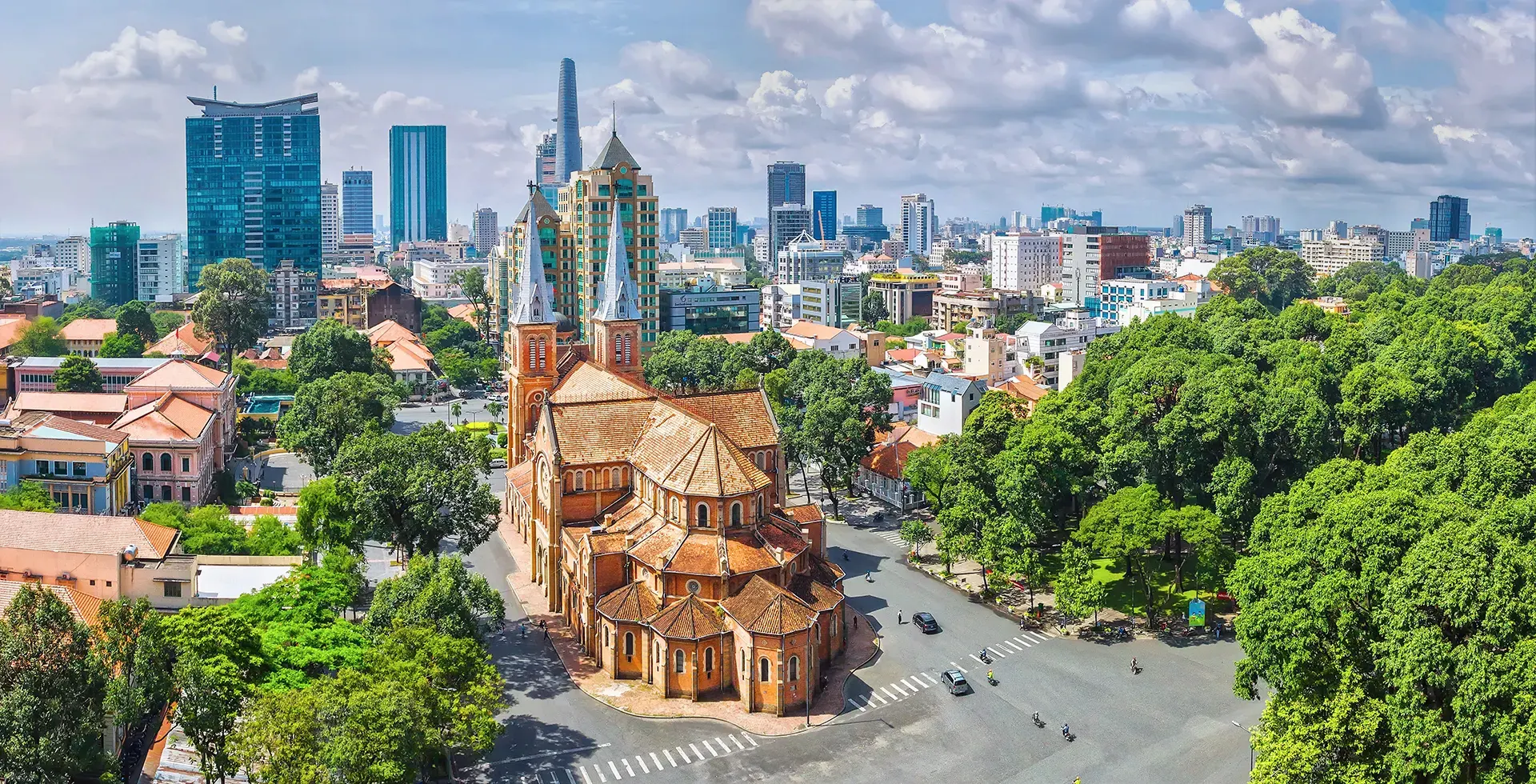
Notre Dame Cathedral
Notre Dame Cathedral. From the post office, you'll stroll next door to Notre Dame Cathedral, another architectural marvel. This Romanesque cathedral, with its twin bell towers and red brick facade, is a serene oasis amidst the bustling city. It's a revered place for local worshippers but is currently under multi-year renovation and entry is not permitted.
Dong Khoi Street. A leisurely walk leads you down Dong Khoi Street, a vibrant and bustling thoroughfare in the heart of Saigon. This street is a mix of old and new, with luxury shops, charming boutiques, and historic sites. Along Dong Khoi Street, you'd experience the dynamic pulse of the city, with the blend of colonial-era buildings and modern establishments. This street has a lively atmosphere and is a great place to absorb the local culture. Throughout the walk, you'd witness the blending of historic and modern elements, showcasing Saigon's rich history and its rapid development. It's a journey that offers insights into the city's past and present, making it an unforgettable experience.
(Overnight – Lotte Hotel Saigon)
Day 11: Saigon - Siem Reap, Cambodia. (Breakfast and Lunch)
War Remnants Museum. You are assisted with your check-out in the morning and a short drive will bring you to the War Remnants Museum. We do not recommend this museum to guests who might get upset by gruesome war photos, descriptions, and exhibits. Also, please bear in mind that the atrocities exhibited are those attributed to American soldiers, during what Vietnam calls the American War. For those that want to forego the museum, you can enjoy your spectacular hotel until the mid-morning or explore surrounding District 1 on your own.
Ten Thousand Buddha Temple. In the mid-morning you will be driven to this unique Temple in District 5 of Saigon. Although Vietnam is not a Buddhist nation, this unique temple draws locals for prayer and tourism. The temple features beautifully carved wooden altars, granite staircases, and detailed reliefs that depict various Buddhist tales and figures. The decorations include golden gilt carvings and vibrant paintings of Guanyin and other deities. The central attraction on the fourth floor is a large Buddha statue surrounded by 10,000 smaller Buddha statues creating a mesmerizing visual experience for visitors. This main hall is a sight to behold with its intricate decorations and serene atmosphere.
Fly to Siem Reap. After lunch you are driven to the airport where your Vietnamese Tour Director Guide will bid you farewell and you will self-board your flight to Siem Reap, Cambodia. Arrive in Siem Reap and you are driven to your top-ranked boutique upscale hotel and assisted with your check-in. The Shinta Mani Angkor is a boutique upscale property with a blend of contemporary style and traditional Khmer elements, set within lush gardens in the heart of Siem Reap's French Quarter. Conveniently located within walking distance of Pub Street, the Old Market, and other attractions, the hotel has exceptional service, beautiful design, and a tranquil environment.
(Overnight – Shinta Mani Angkor)
Day 12: Siem Reap. (Breakfast and Lunch)
Angkor Wat Sunrise. Rising before dawn, proceed for your exploration of the most famous temple in Southeast Asia, Angkor Wat. Believed to be the world's largest religious building, this 12th century temple is a perfect fusion of symbolism and symmetry and a source of pride and strength to all Khmers. Arrive at the monuments entrance before the sun rises and walk to a location near the temple, where your sunrise view of Angkor Wat is across lotus ponds. This is the best time to visit Angkor Wat because it is the least crowded during the early morning, and watching the sunrise over the awe-inspiring complex is an experience not to be missed. After admiring the sunrise, you will proceed into the massive complex to discover its incredible structures and plethora of intricacies, which will be highlighted by your Tour Director Guide. After exploring Angkor Wat, you are driven back to your resort for to have breakfast and some time to freshen up.
Angkor National Museum Curated Tour. In the late morning you will enjoy a curated tour of the Angkor National Museum. This visit and your time with the curator will enhance your understanding and experience in the Angkor Region. The museum currently houses a vast collection of priceless Angkorian artefacts and art, among other things. There are 8 Galleries, each dealing with a specific Khmer Period, including two that are devoted to Angkor Wat and Angkor Thom that you will visit.
Angkor Thom. After a break for lunch, you will explore the immense walled city of Angkor Thom and its multiple awe-inspiring monuments built at a scale that is simply amazing. Following the occupation of Angkor by the Chams from 1177 to 1181, the king decided to build an impregnable fortress at the heart of his empire. The causeway is lined by an intricate bridge depicting the Churning of the Ocean of Milk from Hindu mythology in which the Devas (gods) and Asuras (devils) are engaged in tug of war with a Naga (seven-headed serpent) to obtain the elixir of immortality. Begin your visit at the Terrace of the Leper King. This intricately carved platform was the royal crematorium and the statue that was originally thought to be the leper king is now believed to be Yama, the god of death.
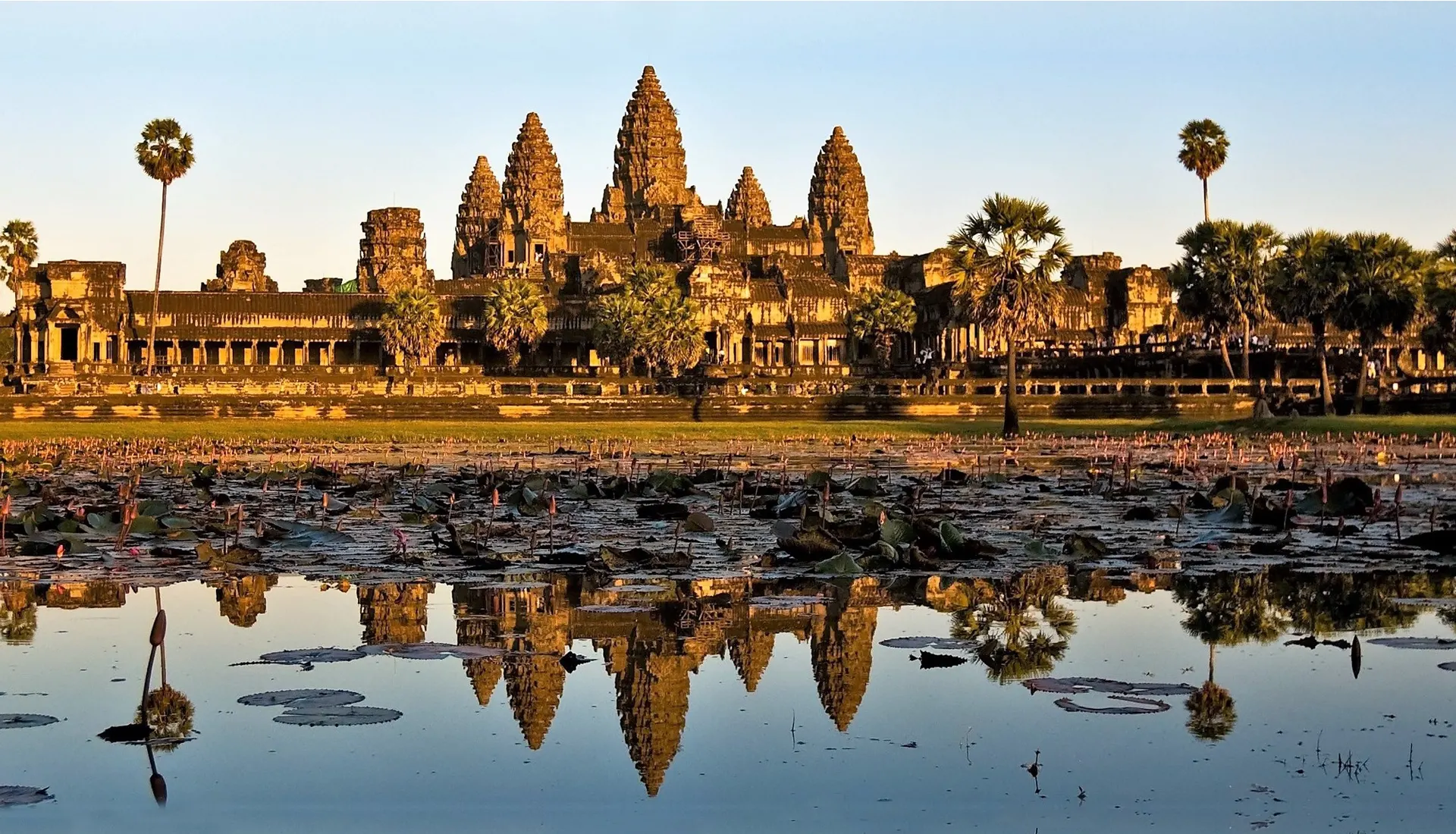
Angkor Wat
The Enigmatic Bayon Temple and More. You will continue along the Terrace of Elephants, originally used as a viewing gallery for the king to preside over parades, performances, and sporting events. At the southern end lies the Baphuon, once of the most beautiful temples at Angkor, dating from the 11th century. It has undergone a massive renovation by the French and is now once again open for viewing. Next up is the enigmatic and enchanting temple of the Bayon. At the exact center of Angkor Thom, this is an eccentric expression of the creative genius and inflated ego of Cambodia’s most celebrated king. Its 54 towers are each topped off with the four faces of Avalokiteshvara (Buddha of Compassion), all of which bear more than a passing resemblance to the king himself.
Ta Prohm and Preah Khan. A fitting end to your Angkor Thom exploration is the mystical Ta Prohm, which has been abandoned to the elements. Left as it was discovered by French explorer Henri Mouhout in 1860, the tentacle-like tree roots here are slowly strangling the surviving stones. This was one of the settings for the original Tomb Raider movie. Complete your exploration of this section of Angkor’s wealth of monuments with a visit to another temple that makes you feel like you have traveled back in time - Preah Khan. This large temple has also been left unrestored for the most part and is a fascinating maze of narrow passageways and windows that each offers their own unique view into the past.
Siem Reap Night Market – This evening, guests who want to experience Siem Reap’s most popular night market will join your Guide for a fascinating walk through the local night market to shop for all sorts of souvenirs and locally made apparel. This is a very large and colorful market with scores of stalls and haggling is expected.
(Overnight – Shinta Mani Angkor)
Day 13: Siem Reap. (Breakfast and Lunch)
Banteay Srei.Join your Tour Director Guide at 8:30 AM for a very scenic 45 to 60-minute drive through the Cambodian countryside to Banteay Srei, which means the Citadel of the Women, or Citadel of Beauty. The name Banteay Srei probably comes from the unmatched details in the carvings of the voluptuous and beautiful Apsaras and Hindu Gods and Goddesses. Constructed from hard Red Sandstone, this small complex is a study in detail and the intricacy of its original sculptures is amazing to behold and is unsurpassed even among all the wonders found in the Angkor region.
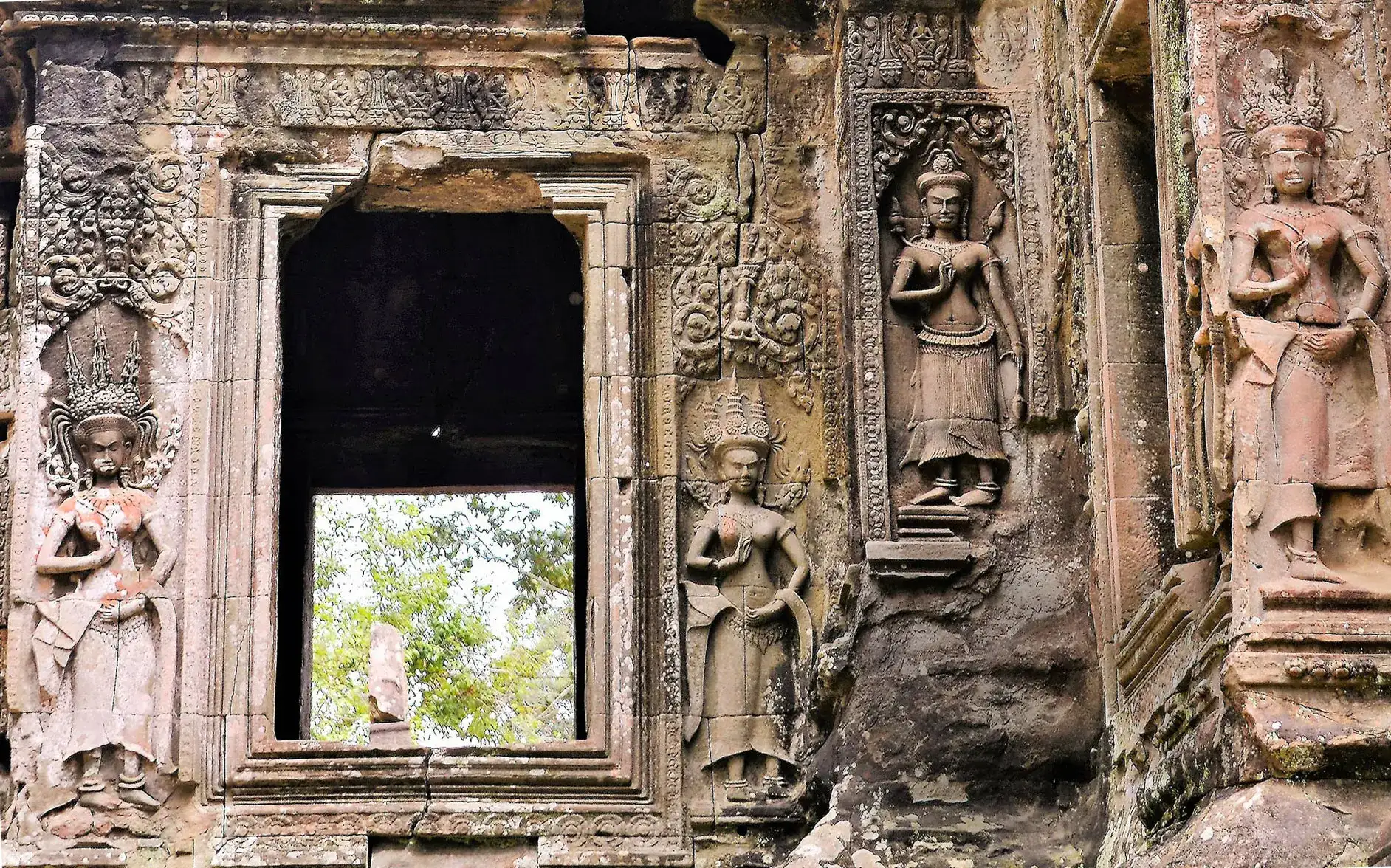
Apsara's at Banteay Srei
Citadel of the Women. The best time to visit Banteay Srei is in the morning when the sun lights up the red sandstone. Banteay Srei is also dedicated to the Hindu God Shiva, and, at more than a thousand years of age, it is older than almost all of the more significant temples in the Siem Reap Region. Some parts of this temple, more so than in other Angkor Region monuments, are replicas due to theft over the last few decades, before adequate protection was added.
Tonle Sap Lake UNESCO Biosphere Reserve. From Banteay Srei you will head towards Tonle Sap, stopping for lunch along the way. Tonle Sap is the largest freshwater lake in Southeast Asia, the lake is connected to a river of the same name. The area is one of the most biodiverse in the world, and its waters were what sustained the magnificent Angkor civilization, and others before that. The lake loses much of its water during winter, and when the rains come in the late spring/early summer, the lake fills up and rises over 30 feet.
Kampong Khleang. You will board your boat and explore the lakeside fishing community of Kampong Khleang, the largest town on the lake, and no doubt be impressed by the network of houses on up to 30-foot-tall stilts, lush farmlands, and small fishing communities. You will have the opportunity to observe how the locals live and work in this unique environment. Unlike the very touristy and hawker-filled village of Chong Kneas, where almost all other tours go, Kampong Khleang offers a more authentic experience.
(Overnight – Shinta Mani Angkor)
Day 14: Siem Reap – Bangkok. (Breakfast and Lunch)
Checkout and Flight. You are assisted with your checkout in the mid-morning and driven to Siem Reap Airport and assisted in checking-in for your short early afternoon flight to Bangkok. Bid farewell to your Cambodia Guide here. The flight timing allows for avoidance of Bangkok’s infamous rush-hour traffic.
Arrival and Hotel. You are greeted as you exit the customs area at Bangkok airport and then you are driven to a nearby restaurant for a late lunch. After lunch you are driven to your charming upscale hotel on the River of Kings and assisted with your check-in. You are assisted with your check in and you are at leisure for the late afternoon. Chatrium Hotel Riverside Bangkok has views of the Chao Phraya River and the vibrant cityscape. This riverside hotel combines elegance with modern comfort, and your large balcony room has a wonderful view of the river and the city. The hotel's prime location positions it conveniently near some of Bangkok's most iconic attractions.
About Bangkok. The giant metropolis of Bangkok is a fascinating blend of modern skyscrapers, congested traffic, beautiful and ornate Wats (temples), incredible street food, and a lot more. The colorful Thai culture and the easygoing local lifestyle make this unique city even more interesting.
(Overnight – Chatrium Riverside Bangkok)
Day 15: Bangkok. (Breakfast and Lunch) Ayutthaya Excursion
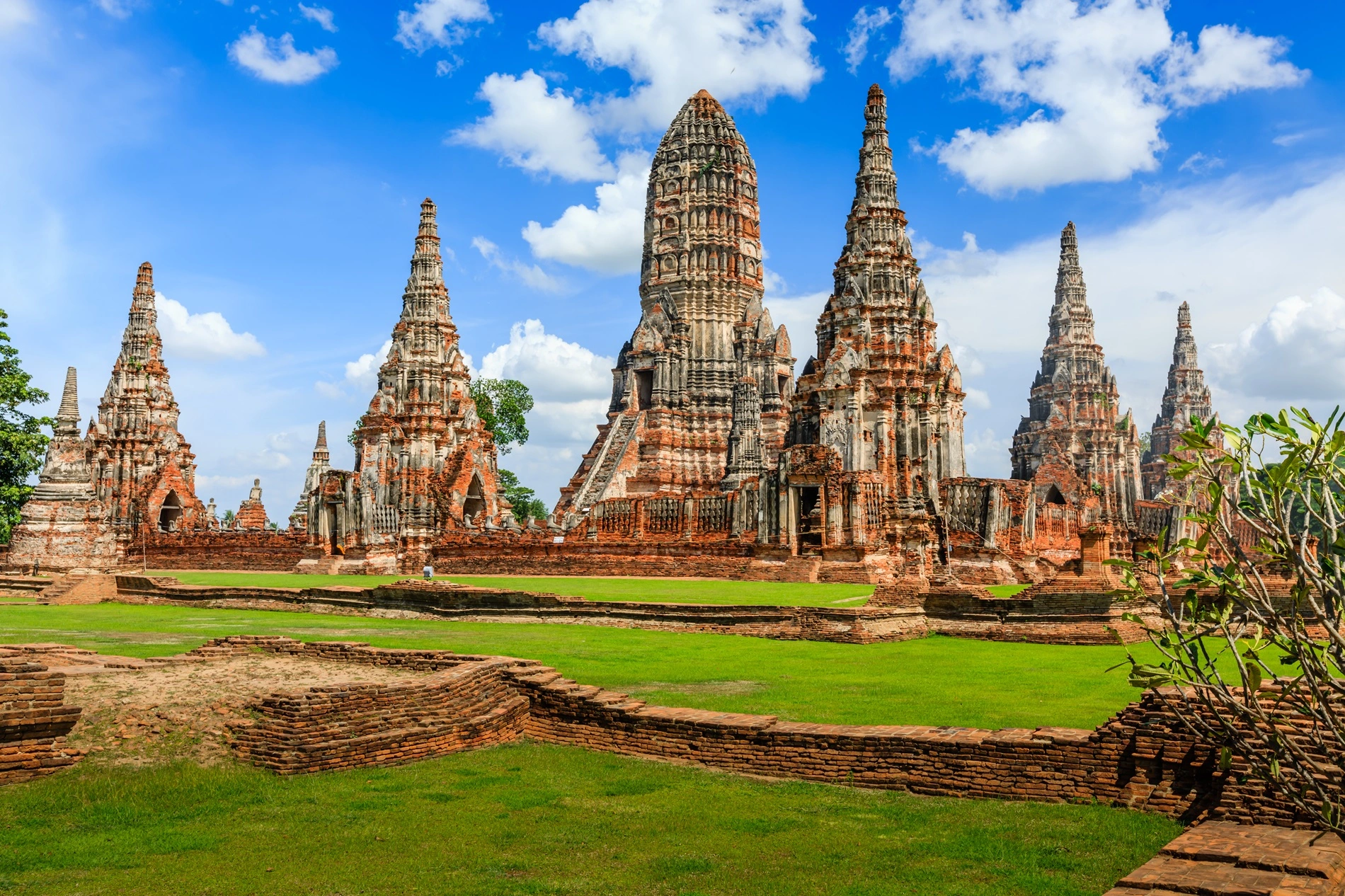
Ayutthaya
Ayutthaya. A 1.5 hour drive each way bring you to Ayutthaya, the last capital of the kingdom of Siam. Ayutthaya is home to the crown jewels of Thailand’s historical monuments, architecturally interesting structures that showcase Thailand’s glorious past. As there is a plethora of such structures dotting the area, you will visit the most impressive monuments, and this visit will enhance your appreciation of the unique Thai culture and its roots in Buddhism.
The Siam Kingdom. Before being sacked by the Burmese army in the late 18th century, Ayutthaya was a thriving city, one of the most important capitals in all of South East Asia. During its golden age, Ayutthaya had strong diplomatic and commercial relationships with existing world powers such as Japan, Portugal and France.
Royal Palace. Start your exploration of the area with a visit to the site of the Royal Palace, which served as home to 33 kings of Siam between 1350 and 1767 A.D. The three large bell shaped chedis of Wat Phra Si Sanphet (the Royal Chapel), which were constructed in the 14th century, stand proud and tall even today, and are perfect examples of Ayutthaya style architecture. There is a break for lunch before you continue your exploration.
Royal Monastery. You will now drive a very short distance to the site of the royal monastery, known as Wat Mahathat. This surreal spot is replete with ancient Buddha statues that range from being in excellent condition, to some that have deteriorated significantly. The statues are spread throughout the towering Khmer-style ruins, and this site also boasts the much-photographed stone carving with the Buddha’s head partially wrapped up by the roots of an ancient banyan tree.
Reclining Buddha. The next stop is Wat Lokayasutharam, the site of Ayutthaya’s largest Reclining Buddha statue, at over 100 feet (31 meters) long and 25 feet (8 meters) high. The last stop, and perhaps the most magical and photogenic in Ayutthaya, is the 17th century Wat Chaiwatthanaram. With its Khmer-style tower and surrounding prangs, it bears a resemblance to Angkor Wat, and may have been built to commemorate the king’s victory over Cambodia.
At the end of your exploration of Siam’s antiquities, you are driven back to your hotel in Bangkok.
(Overnight – Chatrium Riverside Bangkok)
Day 16: Bangkok. (Breakfast and Lunch) Your morning will start with a drive to North Bangkok.
Chatuchak Weekend Market. Spread over 30 acres with more than 10,000 stalls, this market originated in 1942 and is the oldest, largest, and most diverse weekend market on our planet. Literally anything a local or a visitor could possibly want is available here, and we need to mention that group members are not going to be able to stop at multiple stalls and haggle. The colors, activity and general feel are a joy to experience on a walk through an interesting section of the market.
Jim Thompson's House & Museum. Next, you will drive to a great introduction to Bangkok before it became the major city it is today. Before his disappearance in Malaysia over a half century ago, the silk magnate collected an incredible plethora of Southeast Asian art, from Thailand and many other surrounding nations. He had a beautiful home constructed to showcase part of his collection, and also had the museum constructed to house the rest of the collection. The museum buildings themselves are fascinating as they include ancient wooden homes that were brought in from all around Thailand, as well as new wooden construction. You will experience a well-designed tour of the facilities conducted by an expert from the museum.
Riverside Lunch and Flower Market. From here you will proceed to a very nice riverfront restaurant where you will enjoy lunch. Besides the great food, you will have excellent views of the busy river and Wat Arun on the opposite riverbank. An interesting 7-to-8-minute walk will bring you to Thailand’s largest flower market, where millions of amazing flowers are spread across hundreds of stalls. Flowers are an integral part of Thai society, and the plethora of fragrant colors amidst the extremely busy shops and stalls are a delight to experience.
Wat Pho. A very short walk leads to Wat Pho, known as The Temple of the Reclining Buddha. The famous statue of the Buddha is 50 feet (15 meters) high and 140 feet (43 meters) long and is covered in gold leaf. The bottoms of the feet are inlaid with mother of pearl, divided into 108 panels depicting the 108 auspicious symbols used by the Buddha.
Grand Palace. Another very short walk will bring you to the Grand Palace complex, which has been the state residence of Thai royalty since 1782 and parts of which are still used for official events. Your Guide will show you some of the more interesting highlights of the complex. The collection of buildings serves as a nice introduction to Thai architecture and provides many great photo opportunities. Just one of the several stops you will make within the complex is Wat Phra Kaew, also known as the Temple of the Emerald Buddha. This is the most sacred Buddhist temple (wat) in all of Thailand. Except for the Thai King, no other person is allowed to touch this statue. The King changes the statue’s cloak three times each year to correspond to the summer, winter, and rainy seasons.
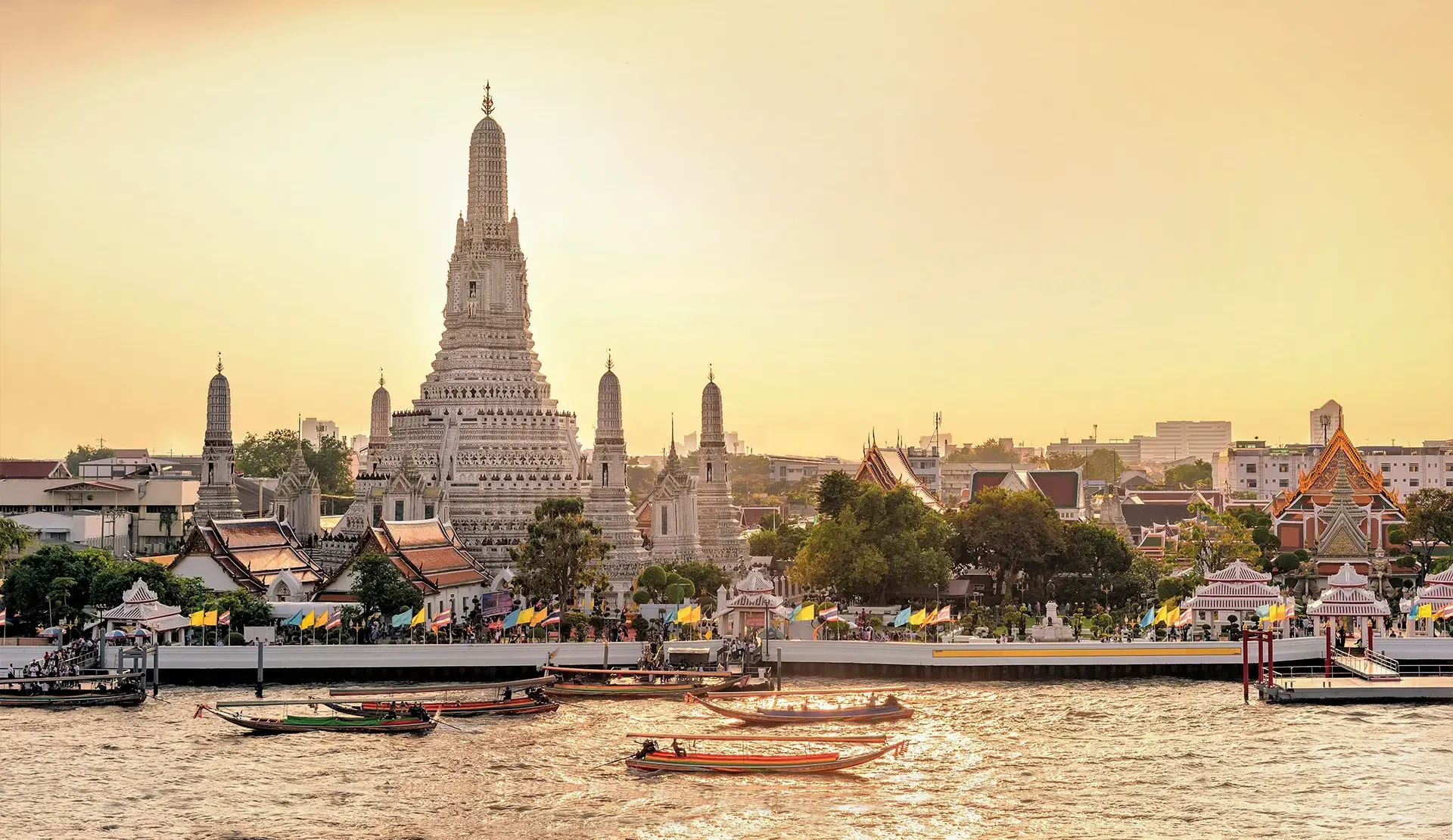
Wat Arun
Wat Arun. You are escorted to your private boat on which you will cross the River of Kings to the spectacular Wat Arun (Temple of the Dawn), which is by far the most striking structure in Bangkok, and is the city’s iconic riverside monument. This is the most unique historic temple structure in Thailand, very different from anything else you will experience, however, as with other Thai places of worship, bare legs and shoulders are not acceptable.
Please do not climb the steps as they are deceptively steep (12 to 15 inches in height) and there is inadequate or nonexistent support for hands. This is Non-Negotiable for anyone who selects to tour with us.
After the temple, you will board your boat again, and cruise back your hotel as dusk settles over Bangkok.
(Overnight – Chatrium Riverside Bangkok)
Day 17: Bangkok – Chiang Mai. (Breakfast and Lunch) You are assisted with your check-out in the slightly early morning and driven to the airport to board your flight to Chiang Mai, capital of the fascinating Lanna Kingdom. Arrive at Chiang Mai and begin your exploration with the historic walled city, one of the most charming ancient cities in Southeast Asia. This tour demonstrates the architectural diversity and blending of styles that the Lanna people were famous for. It is also a great way to get familiar with the city, should you decide to go out during the evenings to explore on your own.
Lanna Kingdom. The Lanna Kingdom flourished in northern Thailand between the 12th and 15th centuries, and Chiang Mai was the longtime capital of the kingdom after it was moved from Chiang Rai. The city is the second largest city in Thailand, and the cultural capital of the north. Possessing great natural beauty and a host of outdoor activities and parks on its outskirts, the city itself is a fascinating combination of unique architecture, ancient history with its associated rituals, and a modern metropolis. You will visit the 3 most significant ancient monuments in Chiang Mai, all located within the Old City walls.
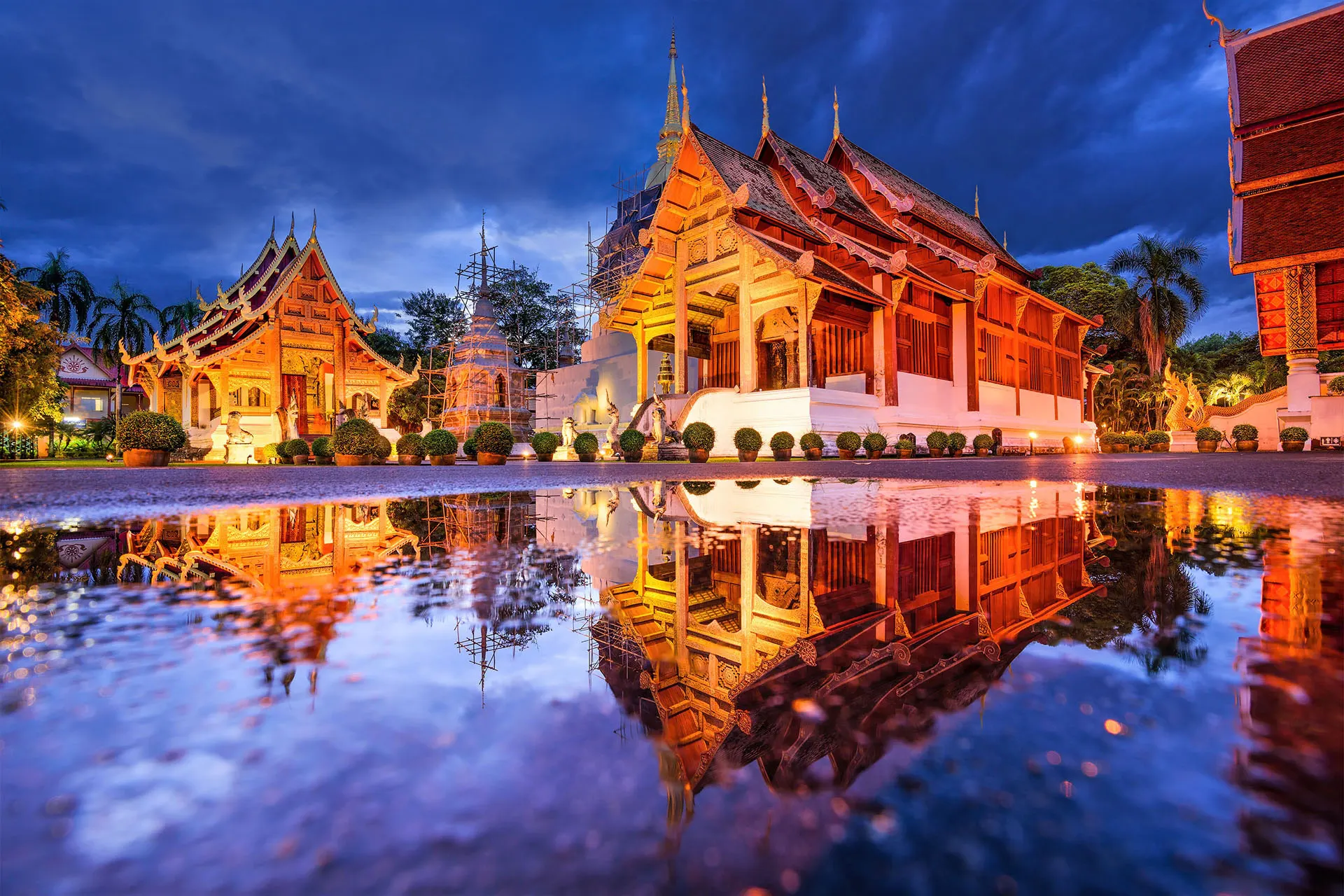
Wat Phra Singh in Chiang Mai
Wat Phra Singh is located within the old city walls of Chiang Mai and is one of the city's most important temples. Established in the 14th century, Wat Phra Singh is renowned for its Lanna-style architecture, intricate wood carvings, and beautiful murals. It houses the Phra Singh Buddha, a highly revered Buddha image, which gives the temple its name. The temple complex includes several buildings of historical and religious significance, making it a center for religious ceremonies and a focal point for Songkran (Thai New Year) festivities in Chiang Mai.
Wat Chedi Luang is famous for its massive chedi (pagoda), which was originally constructed in the 14th century but was partially destroyed by an earthquake in the 16th century. Despite its damage, the chedi remains an impressive structure and is one of the most iconic landmarks of Chiang Mai. Wat Chedi Luang also once housed the Emerald Buddha, Thailand's most sacred Buddha image, now located in Bangkok. The temple serves as a key site for religious ceremonies and is known for its ordination hall built in the traditional Lanna style.
Wat Chiang Man is the oldest temple in Chiang Mai, believed to have been built in the late 13th century by King Mengrai, the founder of Chiang Mai. Wat Chiang Man is known for its ancient chedi supported by rows of elephant figures and houses two important and venerated Buddha images: the Phra Sila (Stone Buddha) and the Phra Satang Man (Crystal Buddha). The temple's architecture reflects the early Lanna style, with intricate wood carvings and stucco work.
Lunch and Check-in. There is a break for lunch at a highly rated restaurant in the Old City. After lunch you will be assisted with your check-in to your suite at your beautiful boutique riverfront resort. Na Nirand offers a harmonious blend of contemporary design and traditional Thai elements, on the banks of the picturesque Ping River. The location is ideal for exploring Chiang Mai, and the facilities and service at are exemplary.
Doi Suthep. In the mid-afternoon you will proceed on the short drive up to Doi Suthep, the hill on the edge of the city that dominates the Chiang Mai skyline. Once at the top, you will find the 309 stairs up to Wat Phra That Doi Suthep, which are flanked on each side by beautiful Nagas running the entire length of the stairs. You also have the option of taking a large elevator (which does usually have a short waiting line) up to the Wat. Once at the top, enjoy the spiritual ambience of one of Thailand’s most holy places, as well as some superb sunset views of the city. You will see devout Thai’s circling the main stupa in a ritualistic manner, and many others on their knees in deep prayer.
Night Market. Join your Country Connoisseur Guide this evening for an excursion to Chiang Mai’s largest night market. It is a fascinating street food scene with its crowds and activity making it another one of Southeast Asia’s amazing photo opportunities.
(Overnight – Na Nirand)
Day 18: Chiang Mai - Doi Inthanon Excursion. (Breakfast and Lunch)
Doi Inthanon National Park. Head to spectacular Doi Inthanon Mountain, an excursion that includes a visit to the most photographed attraction in Northern Thailand, the Royal Chedis, Phra Mahathat Naphamethanidon and Phra Naphaphonphumisiri. Doi Inthanon National Park is a protected area that is home to the highest mountain in Thailand, Doi Inthanon. This is a full day excursion and you will get back to your resort in the evening.
Views and Nature. Doi Inthanon is a superb national park full of majestic waterfalls, lush green valleys, terraced paddy fields, fruit, flower and vegetables crops, and ethnic communities living comfortably in their natural environment. Once at the peak you will admire the views, and then enjoy an easy trek through the mist laden virgin forest and admire the unique flora that is found here. Depending on water levels, there may be one or two stops at waterfalls.
Royal Project Kitchen. After this adventure you will be driven downhill and lunch will be at the Royal Project Kitchen (with fresh natural and organic ingredients from project farmers), while admiring the beautiful surroundings and views. After lunch there will be two more not-to-be-missed experiences on your way back to Chiang Mai.
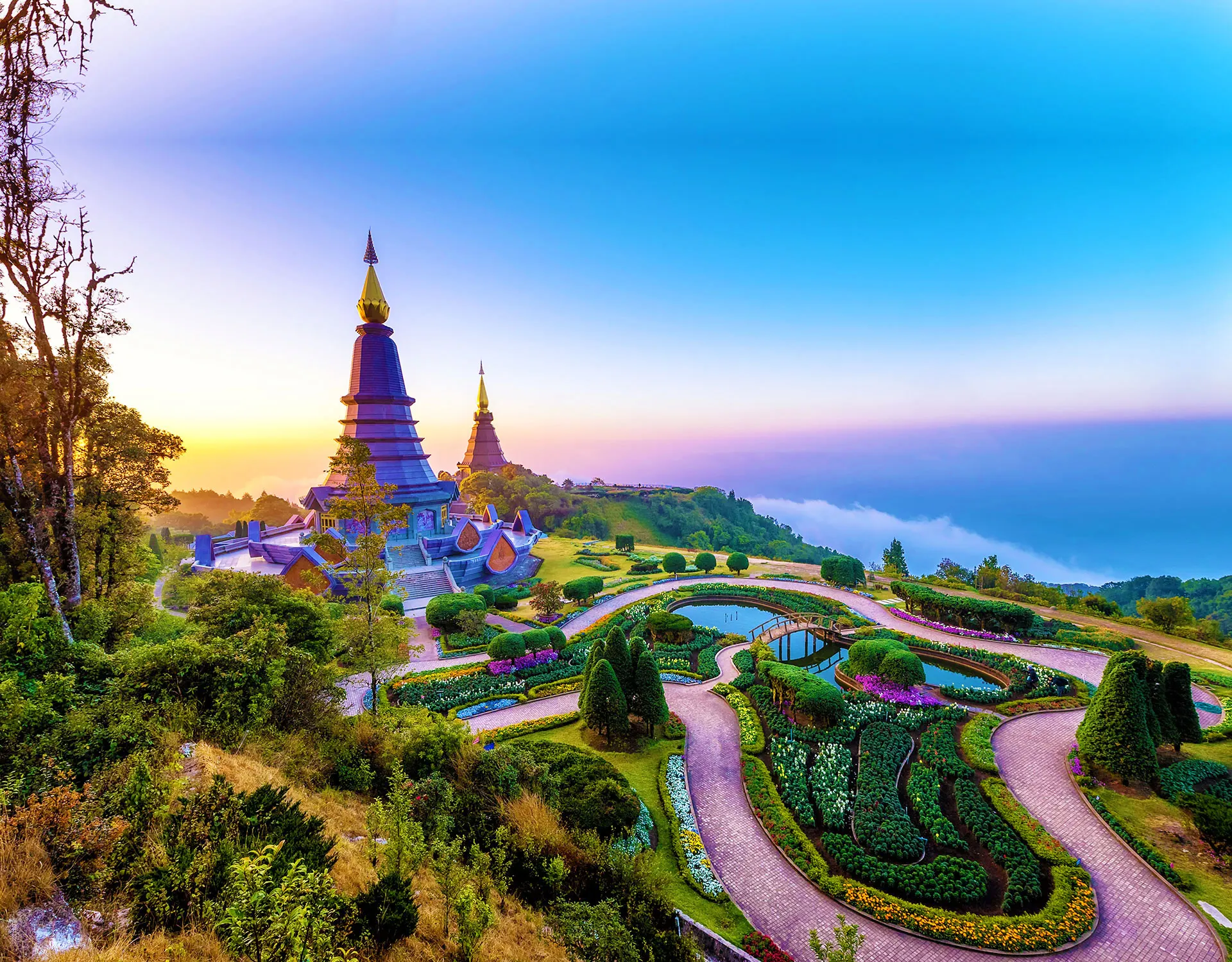
Royal Chedis at Doi Inthanon
Royal Chedis. Next you will stop at the two afore-mentioned spectacular Chedis, which are dedicated to the Beloved Late King and the Revered Queen and are located in a magical spot with lush undulating hills and spectacular views. The immaculate terraced gardens with a plethora of colorful exotic flowerbeds that surround the Chedis make for a breathtaking locale and a fantastic photo opportunity. These massive and gorgeous Chedis are the subject of the most popular photos that travel journals and websites use for the Chiang Mai region, and are not situated in Chiang Mai, but close to the peak of Doi Inthanon.
Hill Tribe Market. Your last stop as you head down the mountain is the Royal Projects Highway Market run by the Hill Tribes of the Doi Inthanon region. You will stop and walk around the outdoor stalls selling fruits, produce, nuts and other items organically grown by the simple and now well-to-do tribal locals, some of whom will be dressed in their unique clothing. This market, its wares, and the tribal people that grow and sell here are a growing testament of the success of the Late King’s vision and efforts. After this you will return to your boutique resort arriving in the evening.(Overnight – Na Nirand)
Day 19: Chiang Mai – Elephant Park (Breakfast and Lunch)
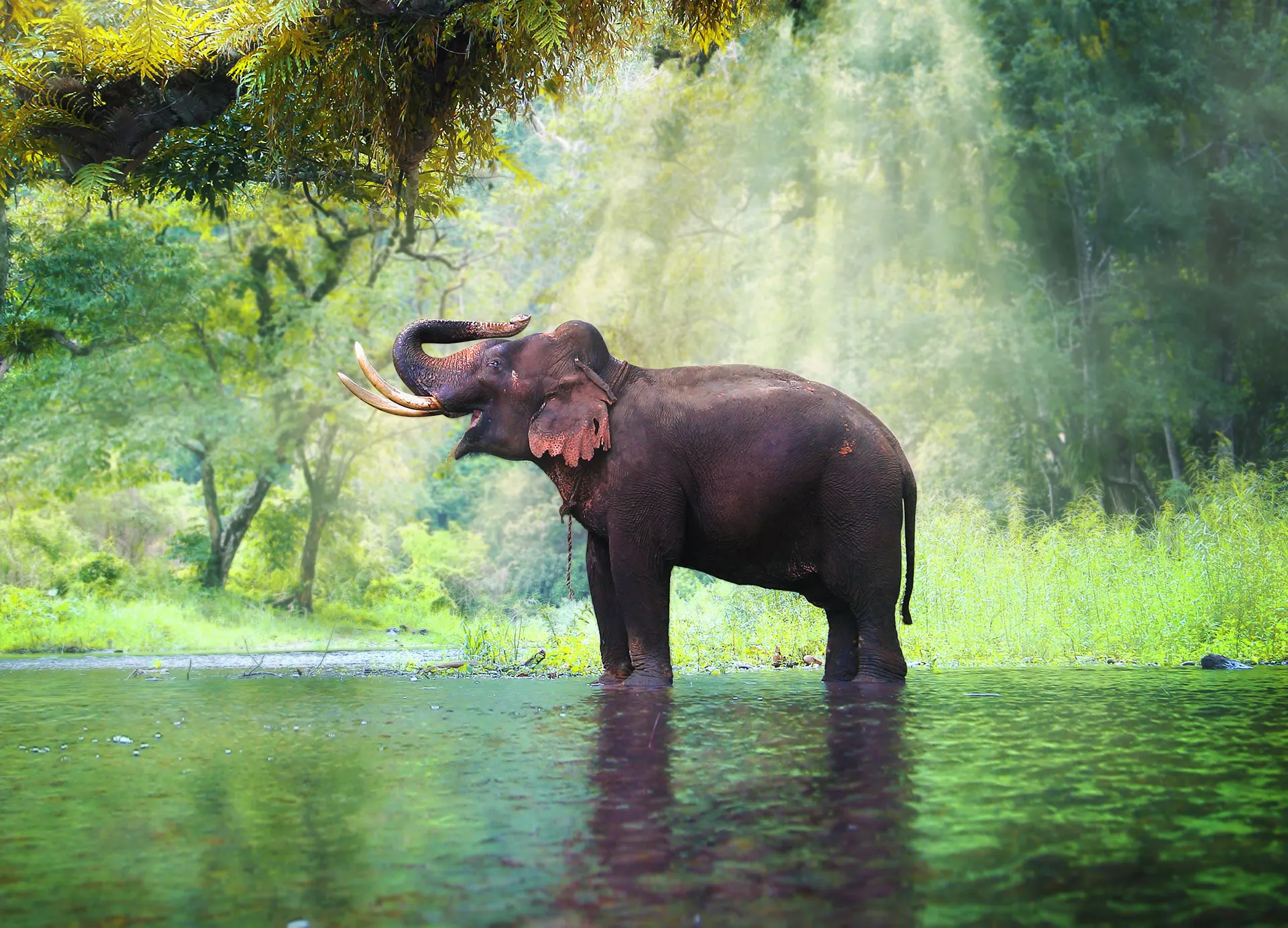
Tusker
Baan Chang Elephant Park (No Elephant Riding). After an early breakfast this morning you will head out with your Thailand Connoisseur Guide and drive out to the mountains to enjoy some time with Thailand’s iconic animal – the elephant. You will be spending the day at one of the finest elephant camps in Northern Thailand and taking part in a hands-on experience that will allow you to truly interact with these majestic animals.
Baan Chang Camp stopped offering Elephant Riding a while back, and even when they did offer that activity, they never used cages for riding. The “Elephant Day Care” is an interactive and personalized program that aims to spread knowledge about elephant conservation efforts while creating a unique and special experience for everyone who joins. The current schedule, as per the camp operator, is as follows:
Arrive at Baan Chang Elephant Park, change into traditional clothing.
Prepare fruits for the elephants and meet the elephants. Feeding, roaming, touching, and playing with elephants.
12:00 pm Lunch
1:00 pm Prepare and cook sticky rice in order to be mixed with herbal stuff for the elephants. Learn about the background, health care and behavior of elephants.
2:00 pm Enjoy more time roaming, feeding and taking the elephants for a walk to a clean water pond where they will cool themselves off and you will have a chance to observe and join them in bathing as well. Feed sticky rice balls and fruits to the elephants. This part is focused on taking your time and allowing the elephants to enjoy each moment of their freedom, scratching, rubbing, and throwing dirt on their backs, an activity that is good for their skin.
** Tea and coffee break.
Visit and play with the baby elephants in the Nursery Zone.
At about 3 PM you will join your Guide and be driven back to your Chiang Mai resort, arriving at about 4 PM.
(Overnight – Na Nirand)
Day 20: Chiang Mai – Chiang Rai. (Breakfast and Lunch)
Scenic Drive. You are assisted with your checkout in the morning and you will now proceed on the scenic drive to Chiang Rai. As you leave Chiang Mai, the urban landscape quickly gives way to lush greenery and rolling hills. The route passes through a diverse range of terrains, from flat valleys to mountainous areas, providing a refreshing and ever-changing backdrop. You'll encounter stretches of dense forest, agricultural lands, and small villages, offering glimpses into rural Thai life. The road meanders through hills and alongside rivers, And, as you approach Chiang Rai, the terrain becomes flatter, but the rural charm continues.
Lunch and Check-in. You are driven to your riverfront resort, Chiang Rai’s top-ranked upscale lodging. Upon arrival you will enjoy lunch before you are assisted with your check-in. Your room has a view of the lush and hilly Chiang Rai region, including the beautiful river than runs right next to your resort. You are at leisure for a short while to freshen-up before heading out in the mid-afternoon. Unlike Bangkok and Chiang Mai, Chiang Rai town itself is backpacking traveler oriented and is not recommended for an excursion. The Peak Wine & Grill at your resort offers spectacular views of the river, mountains, and countryside, with usually wonderful sunsets.
Chiang Rai Town. The mountainous region of the north has been significantly influenced by Burmese and Chinese culture due to its proximity to those nations. The culture, language, and food, even the physical appearance of the local Lanna descendants, all stand in subtle contrast to the rest of Thailand. This is Thailand’s northernmost city and was the first capital of the Lanna Kingdom. Today it is the commercial center of the once infamous Golden Triangle Region. Chiang Rai is tiny compared to Chiang Mai, and this northern outpost has an even slower pace and a markedly laid-back feel. Arriving at Chiang Rai there is a break for lunch.
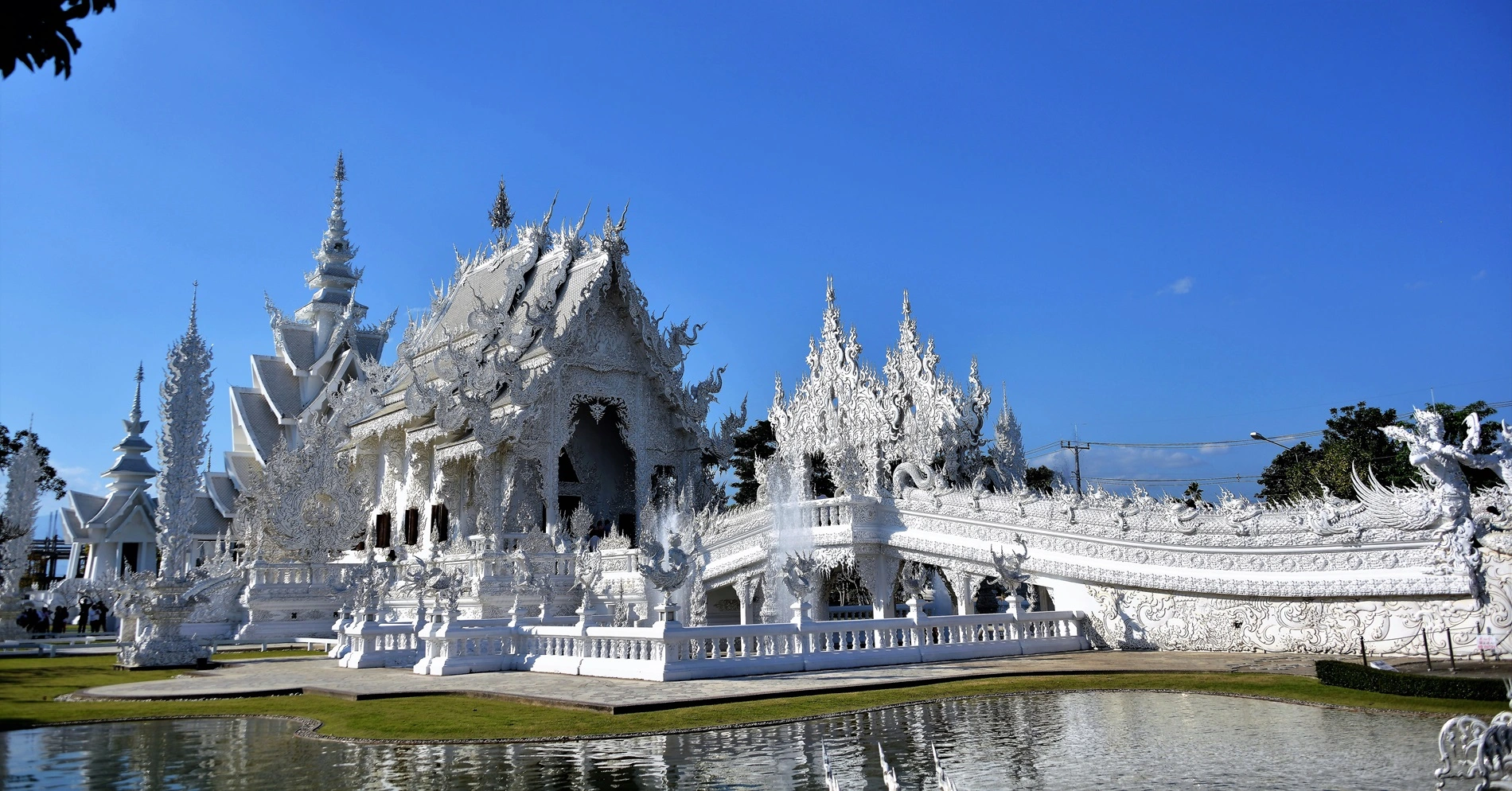
The White Temple
The White Temple. You are driven to a monument that is nothing like anything you have ever seen before, Wat Rong Khun, also known as the White Temple. This recent striking creation of a famous local architect is extremely ornate and beautiful in its design and houses an impressive array of intricate sculptures. This is the attraction that gets the most visitors in the Chiang Rai region and for good reason – it is completely different from any other monument in Southeast Asia.
Wat Phra Kaew. Next you will visit the original Wat Phra Kaew, which was home to the precious Emerald Buddha statue before it was moved to Bangkok. With a known history going back about 700 years, this is one of Northern Thailand’s most revered Buddhist pilgrimage destinations. The beautiful temple complex is housed in gorgeous gardens with orchids and other blooming flora and is far less crowded when compared to Bangkok and Chiang Mai’s main temples. The architecture of the temple, and the quality of the craftsmanship of the statues inside, especially the massive 7 century old brass and copper statue of Lord Buddha in the main chapel, is outstanding.
(Overnight – The Riverie by Kathathani)
Day 21: Chiang Rai. (Breakfast and Lunch)
Ancient Chiang Saen. Continue your exploration of Northern Thailand with a drive to the ancient region of Chiang Saen. Located along the banks of the Mekong River, the once great city was the capital of a Kingdom during the 12th and early 13th centuries. Now all that remains is a sleepy riverside town with some well-preserved remnants amongst beautiful teak and banyan trees.
Three Country River Cruise. At Sop Ruak you will be assisted in boarding your boat for a cruise along the upper Mekong River to the exact coordinates of the Golden Triangle. Cruise the mighty river where the countries of Thailand, Laos, and Burma meet and you will view the lush countryside of each nation as you cruise. This spectacular region was once the infamous location for the production of most of the world’s opium.
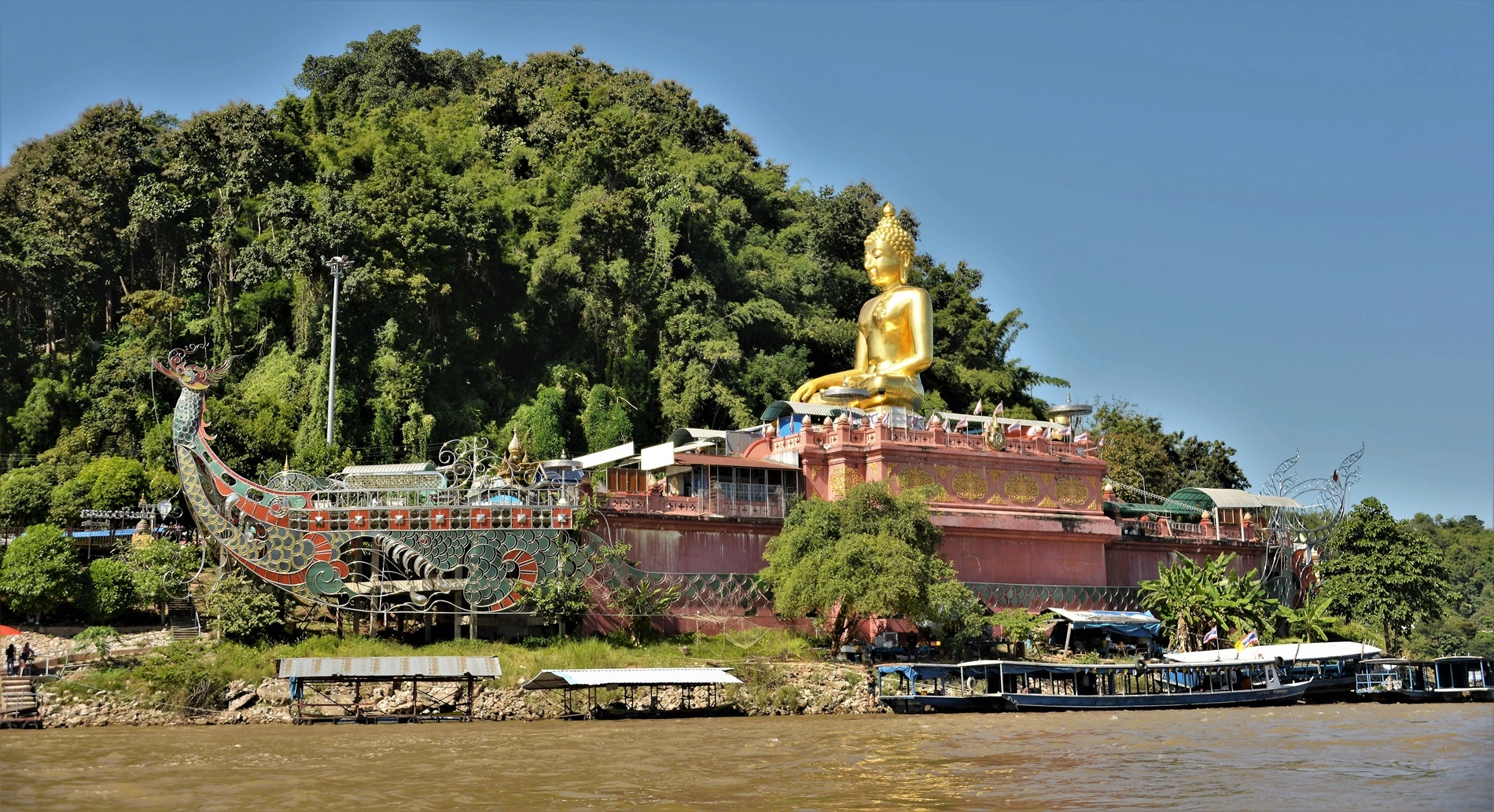
Buddha Statue at Golden Triangle
Hilltop Three Country View. Disembark from the boat and you are driven to a hilltop viewing site where you can clearly see the spot where the three nations meet at the confluence of two rivers. You will break for lunch at the only upscale restaurant in this area and after lunch you will proceed for a scenic drive to the hills near Chiang Rai.
Hill Tribes. Many travel companies continue to paint a picture of the unique traditional clothing, jewelry and lifestyles of Southeast Asia’s hill tribes as if these have remained unchanged over the last few decades. The truth is quite the opposite. The hill tribes were an integral part of poppy farming for a long time, and supported themselves and their unique lifestyles through its cultivation.
Leaving Poppy. About six decades ago the revered late King of Thailand mostly ended the drug cultivation and trade and made significant efforts to uplift and empower the tribal people. His goal was to provide them with alternative livelihoods and education for their children so that they could assimilate into the rest of Thailand’s population. Although some still live in their villages and farm, their lifestyles have changed; they dress like other Thai people do, practice modern cultivation methods, live in brick and mortar houses, speak the Thai dialect that is local to their region, ride motorbikes and drive pickup trucks as part of their daily routine.
Hill Tribe Tourism. There are a handful of locales where the tribal communities have been somewhat preserved in their original form with support from government funded agencies. The agencies’ goal is to provide the few who do not want to change a place to live, while also making them self-sufficient. Easy Tours guests visit one of the better such villages, located near Chiang Rai.
Tribal Village.During this excursion, you will pay a visit to the Kiran (longneck), Akka, Lahu, and Yao tribes. Your Tour Director will introduce you to some of the villagers and explain the origins and customs of these unique tribal peoples. These villagers still honor their heritage by dressing in the vibrant and colorful garments unique to their people. The entry fees to this set of villages supports the hill tribe residents of the village, and the tribal residents also offer hand crafted items for sale, although they are not the least bit aggressive in pushing their wares. You are driven back to your resort in Chiang Rai after walking through the villages.
(Overnight – The Riverie by Kathathani)
Day 22: Chiang Mai – Bangkok – Luang Prabang(Laos). (Breakfast)
Flight to Bangkok, Connecting Flight to Luang Prabang. You are assisted with your check-out at your choice of time in the morning and driven to the Chiang Mai airport and assisted in boarding your no-frills flight to Bangkok’s other Airport, Don Muang, where you will connect with your no-frills flight to Luang Prabang after a 3.5-hour layover. Your bags will be checked through at Chiang Rai.
Laos Arrival. Upon arrival at Luang Prabang, you are greeted at the airport by an Easy Tours Travel Facilitator or your Laos Tour Director Guide, who will usher you to your vehicle. You are driven to your boutique Garden Resort and assisted with check-in to your upgraded room with paddy field and hill range views.
About Luang Prabang. All of Luang Prabang’s Old Town is a UNESCO World Heritage Site and offers visitors a perfect micro chasm of the landscapes and culture of Southeast Asia. Its incredible utopian setting is a perfect accompaniment to this idyllic Buddhist town. UNESCO describes Luang Prabang as “an outstanding example of the fusion of traditional architecture and Lao urban structures with those built by the European colonial authorities in the 19th and 20th centuries. Its unique, remarkably well-preserved townscape illustrates a key stage in the blending of these two distinct cultural traditions.”
Day 23: Luang Prabang. (Breakfast and Lunch)
Tak Bat. An optional pre-sunrise start today gives you the opportunity to participate in one of Luang Prabang’s most iconic traditions: donating food to the local monks (Tak Bat). Your Tour Director Guide will assist you in procuring the groceries and instruct you on the process as the monks walk by silently and open their baskets for you to place your contribution in them. The monks have been collecting their day’s meals in this manner for centuries.
Morning Market. After the ceremony you will enjoy a walk through the nearby fresh food market. The busy market is a hive of activity as locals purchase fresh fruits, vegetables, and fish caught from the Mekong River. Return to your resort hotel for breakfast and a bit of leisure time to freshen up. Join your guide in the late morning and proceed for an exploration of the extremely charming Old Town of Luang Prabang.
Royal Palace Museum is the National Museum of Laos, and was originally built in 1904 as a royal residence. It showcases a blend of traditional Lao and French Beaux-Arts architecture, reflecting the country's colonial past and its rich cultural heritage. The museum houses an extensive collection of artifacts of Lao Royalty, and among its most prized possessions is the Pha Bang, a highly revered Buddha image which the town of Luang Prabang is named after. The exhibits provide insights into the history of Laos, the life of its monarchy, and the country's cultural traditions. The building itself is surrounded by well-maintained gardens, adding to its serene and majestic ambiance.
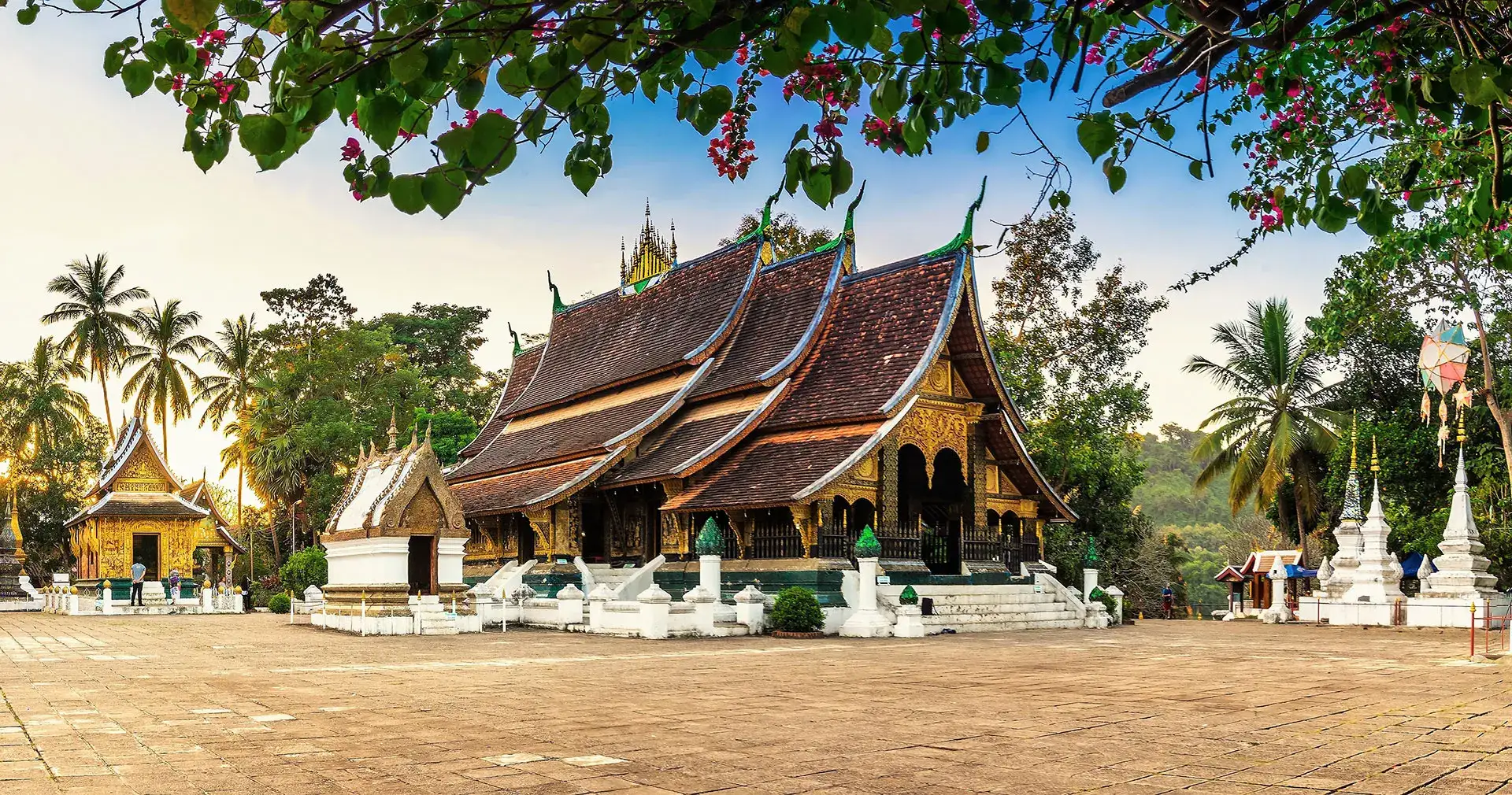
Wat Xiengthong
Wat Xiengthong. Located at the tip of the peninsula where the Mekong and Nam Khan rivers meet, this temple complex dates back to the 16th century and has since been a key site for religious ceremonies and festivals. It also the temple that is featured in Luang Prabang photos as the roofs of the buildings are distinctively low-slung, sweeping towards the ground, even more so than other temple architecture in Luang Prabang. Wat Xieng Thong features several structures, including a main hall (sim), chapels, stupas, and a library, all adorned with intricate carvings, mosaics, and gold leaf decorations. The main hall is particularly famous for its elaborate tree of life mosaic on the rear wall, depicting various Buddhist motifs and stories.
Wat Khili Library. A short walk from here brings you to the nearby Wat Khili. The charming traditional library building here houses a historic photo exhibition of Buddhist heritage, known as The Buddhist Archive of Photography. You will spend just a few minutes with the unique collection of 35,000 historical photographs that were collected by several monk collectors and photographers over 120 years.
From here you will proceed for a lunch break at a boutique restaurant that offers Laotian and western fare.
Arts & Ethnology Centre. Proceed to the Traditional Arts & Ethnology Centre where you will meet one of the two co-founders, Ms. Tara Gujadhur or Ms. Soutthivilay Thongkhoun and experience a Directors Tour that provides insights into the myriad Laos' ethnic cultures and their traditions and customs.
Watermelon Stupa.Next is Luang Prabang’s oldest temple, Wat Visoun, which, because of its design, is known as The Watermelon Stupa. The Stupa dates back to 1503 and is now home to a collection of religious artefacts. As you explore you will learn about the wat’s fascinating history and early Lao Buddhist architecture from your Guide. Return to your resort and its views and facilities in the mid-afternoon.
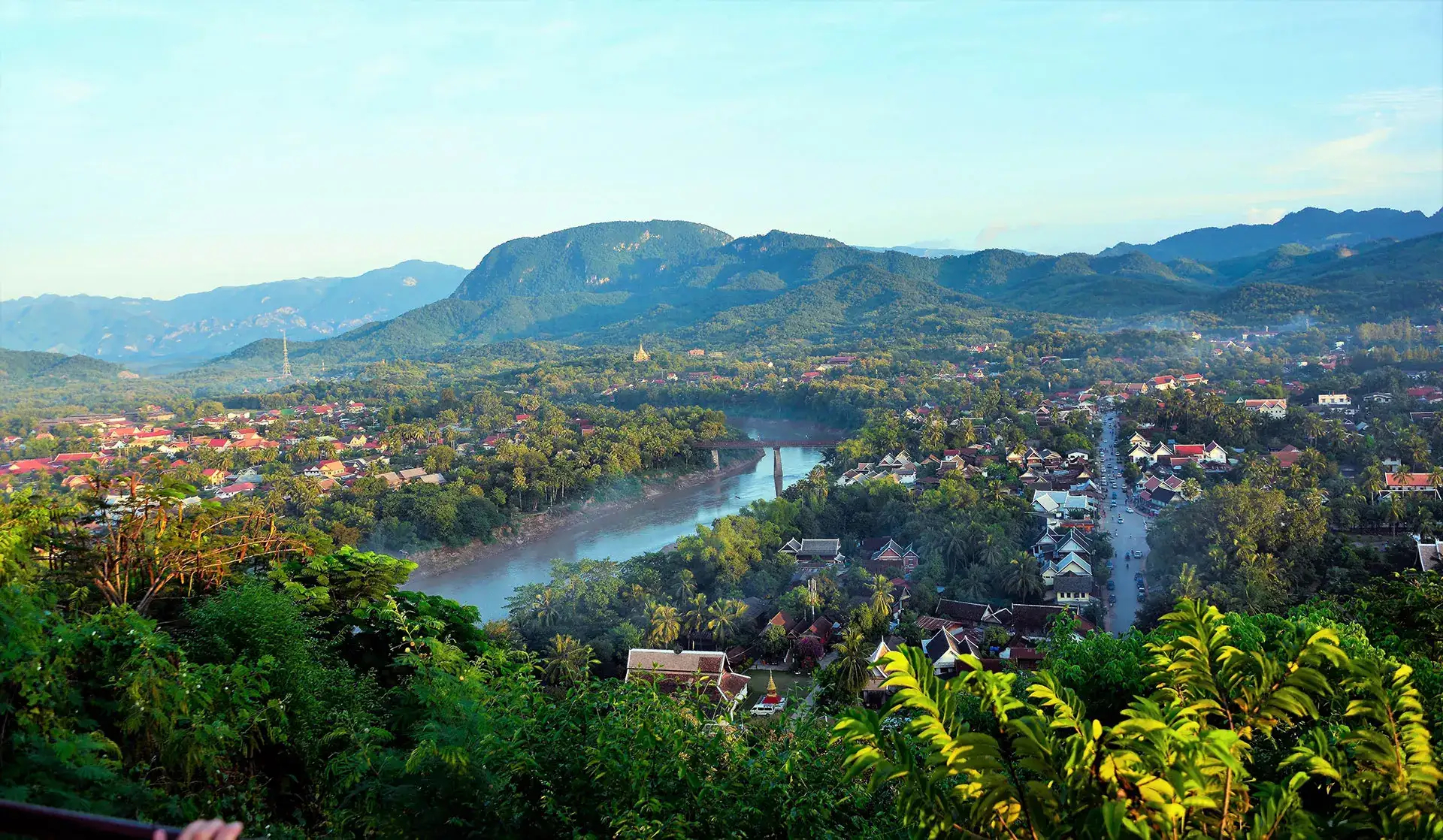
Luang Prabang from Phousi Mountain
Phousi Mountain Sunset. Join your guide for an excursion to Phousi Mountain in the late afternoon. This is a hill in the center of the old town that provides a breathtaking view of the town and the Mekong River at sunset. This excursion involves a fairly rigorous climb up 350 paved steps, but the view from the top is an amazing photographic opportunity, as it showcases the remarkable beauty of Luang Prabang.
(Overnight – Pullman Luang Prabang)
Day 24: Luang Prabang. (Breakfast and Lunch)
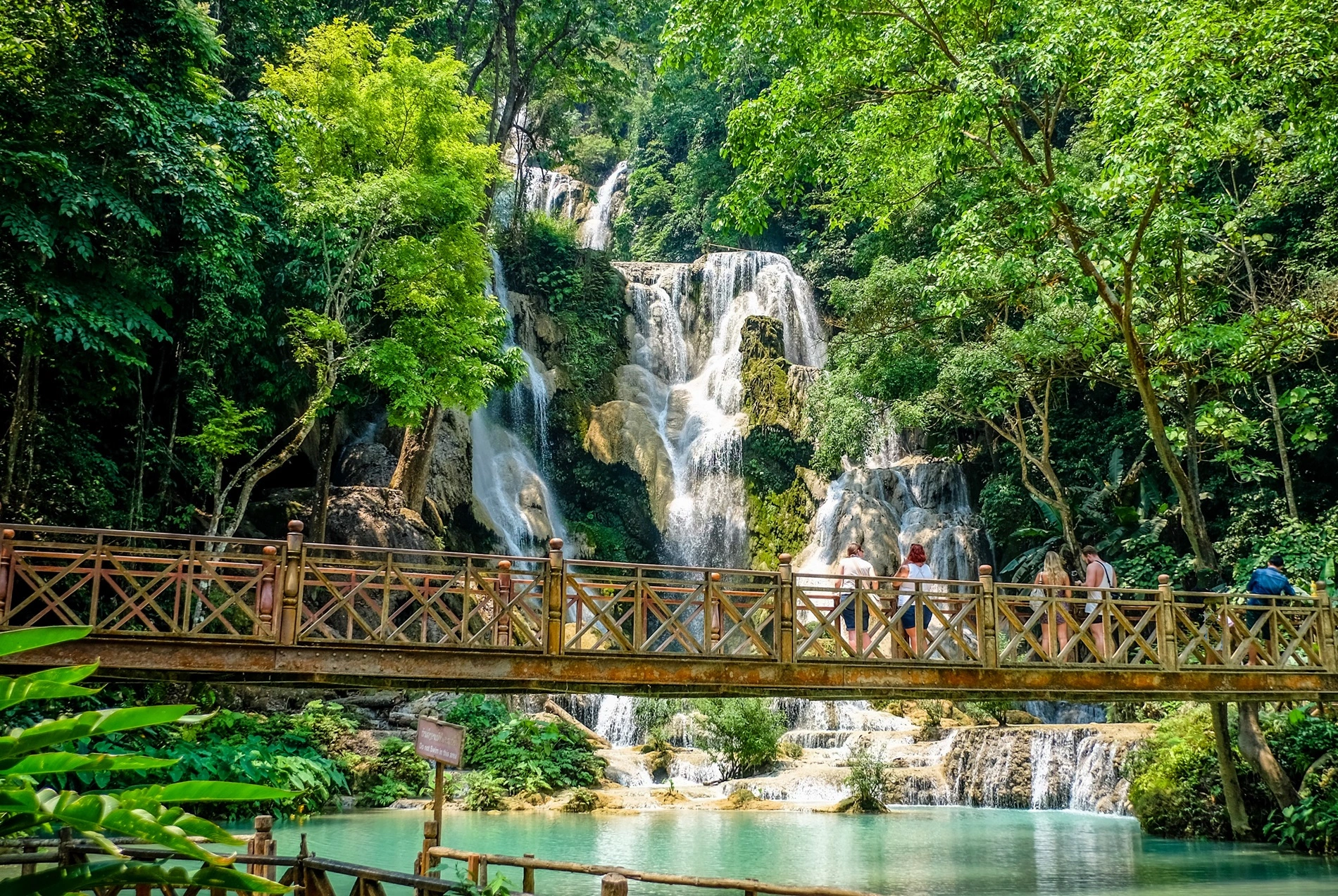
Kuang Si Waterfalls
Kuang Si Waterfalls. You are driven in the morning to the gorgeous set of waterfalls at Kuang Si, a time of day that the falls usually are fairly uncrowded. The roughly 45 minute drive is through picturesque Laotian countryside. Upon your arrival at the entrance, you’ll into the jungle on well- maintained walkways, until you arrive at the first small set of falls. The base of these falls has a beautiful natural blue swimming hole the size of a large public pool – swimming is permitted at all the falls, so you may want to dress appropriately. Continue on your leisurely walk through the jungle, making your way from waterfall to waterfall, to one idyllic swimming hole after another. The finale is a stunning 200 ft. cascade that is the most impressive of the collection of waterfalls.
Nam Ou River Cruise. From the waterfalls, a very scenic rural drive will bring you to the village of Ban Don Ngurn, where you will board a private boat for a cruise down the beautiful Nam Ou River. Your first stop will be for a delicious picnic on the scenic banks of the Nam Ou River, organized by one of Luang Prabang’s best restaurants.
Nam Ou and Mekong River. The cruise then takes you by stunning limestone karst and lush scenery, offering many photo opportunities as you cruise by picturesque landscapes and the occasional tribal hamlet. Continue along the Nam Ou until it merges with the mighty Mekong River, and then continue on to your island cave destination.
Pak Ou Caves. Enjoy a visit to the mysterious Pak Ou Caves. Although the caves are not as massive as some of the famous caves in Southeast Asia, they are very interesting because Buddhists have been venturing here for centuries to place Buddha statues in them. The lower cave contains the largest part of the collection, well over 3000 statues, and hence a fairly arduous climb up some steep stairs to the upper cave is purely optional. After your visit to the caves, you will head back toward Luang Prabang.
Ban Vanglae Village. Continue the cruise until you stop at Ban Vanglae, a Lu tribe village where traditional weaving and dyeing is the main occupation of the villagers and the way of life is deeply connected to the local environment. As you walk through the village and watch the residents go about their daily lives, you’ll notice that many of their homes are made of wood and bamboo, raised off the ground on stilts to protect against flooding during the rainy season, and Its location on the river is crucial for irrigation, fishing, and daily water needs. The social structure is closely knit, with families living in close proximity and community events centered around the local temple or community hall.
Sunset Cruise. As you cruise back towards town, the sun will start to set on the river and you can enjoy the idyllic beauty of your wonderful surroundings and the great views.
(Overnight – Pullman Luang Prabang)
Day 25: Luang Prabang – Bangkok – International Flight. (Breakfast)
Flight to Bangkok. You are assisted with check-out in the mid-morning and driven to the airport to board your flight to Bangkok - bid farewell to your Laos Tour Director Guide at the airport after you are assisted with your check-in for your flight. Additional Services such as lodging at Bangkok Airport, and/or transfers, can be arranged with your U.S. based Guest Care Specialist after tour reservation.
Our Services End at Luang Prabang Airport.
Lodging
| Hanoi | Peridot Grand Hotel – Junior Suite |
| HaLong Bay | Paradise Grand Cruise – Executive Grand Balcony Cabin |
| Hue | Azerai La Residence - Deluxe Room |
| Hoi An | La Siesta Resort – Verandah Suite Club Wing |
| Saigon | Lotte Hotel Saigon – Deluxe River View Room |
| Siem Reap | Shinta Mani Angkor – Bayon Room |
| Bangkok | Chatrium Riverside Bangkok – Grand Deluxe River View |
| Chiang Mai | Na Nirand Romantic Boutique Resort – Romantic Laana Deluxe |
| Chiang Rai | The Riverie by Kathathani – Deluxe River View |
| Luang Prabang | Pullman Luang Prabang – Premium Deluxe Room |
Inclusions
| Accompanying Country Connoisseur Guide for Airport Assistance on all in-country flights |
| Breakfast daily except for Arrival Day |
| Lunch daily except for Arrival and Departure Days, and Travel to Laos Day |
| All meals on HaLong Bay |
| Ground transportation via upscale private vehicles |
| Representative for assistance on departure / arrival transfers per the itinerary |
| Services of the best English-speaking Accompanying Country Connoisseur Guides |
| Applicable monument entrance fees as per the itinerary |
| Bottled water during sightseeing |
| Hotel accommodation as listed above |
| All Boat Fees/Fares per the itinerary |
Not Included
| International travel except countries on your Easy Tours Journey |
| Any expenses of a personal nature, such as tips, laundry, phone calls, drinks etc. |
| Meals other than those specified on itinerary |
| Travel insurance, visas, etc. |
Annual Sale. Aug 16th to Aug 30th
Save 10% On All Our Tours
Subject to Availability of our Preferred Guides & Lodging for Your Dates
Ask Questions Or Send Us Your Dates
Please wait while we are processing your request...





